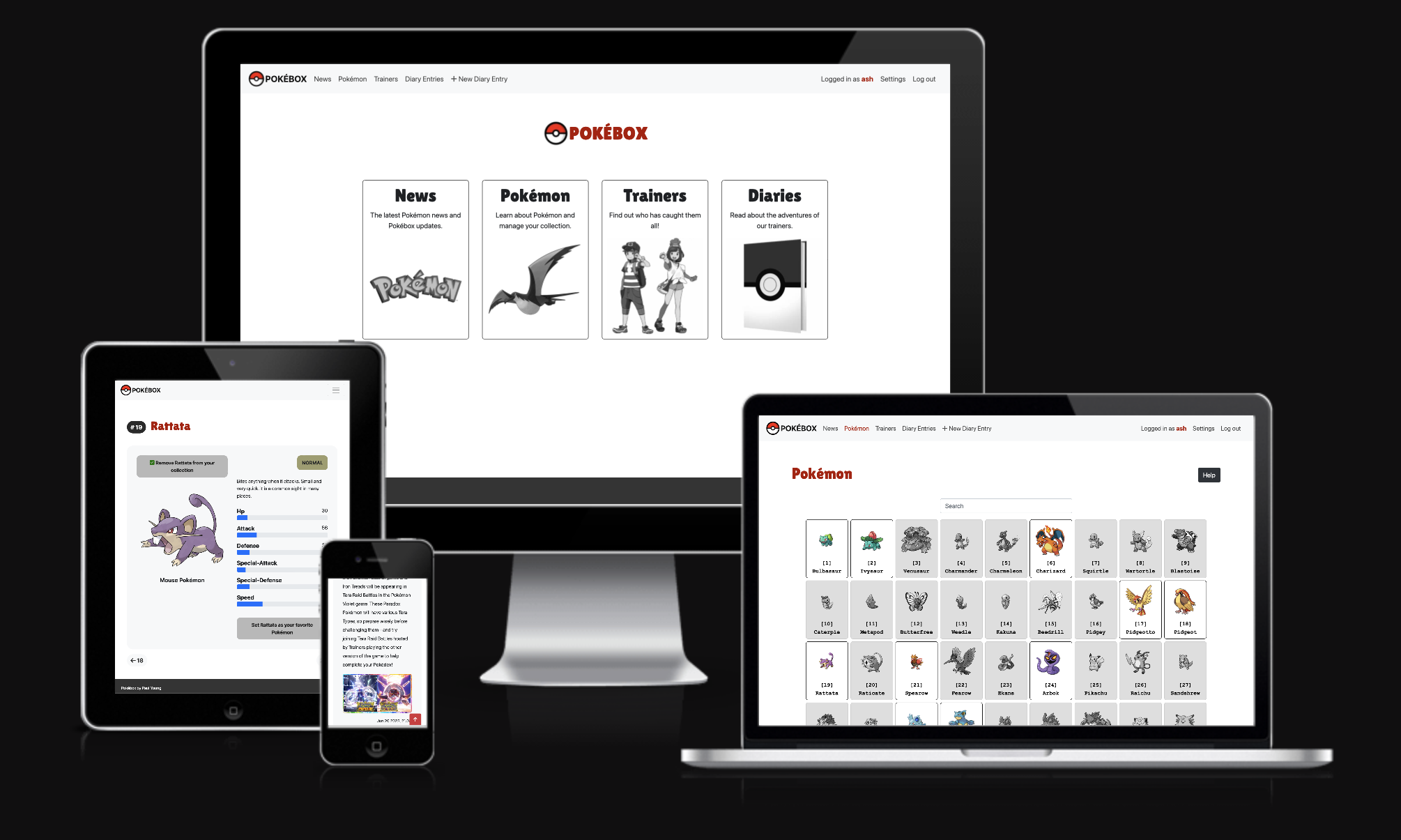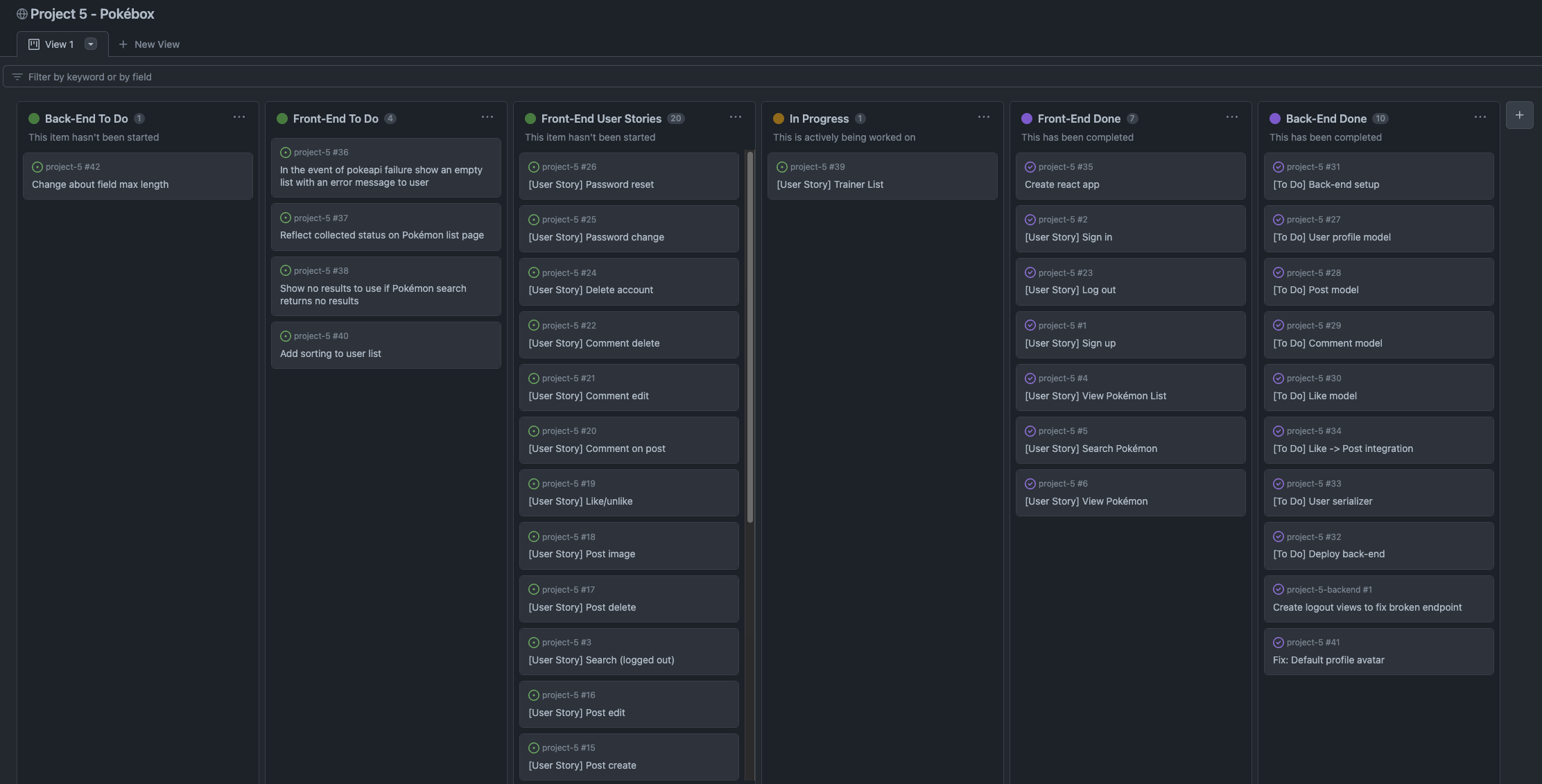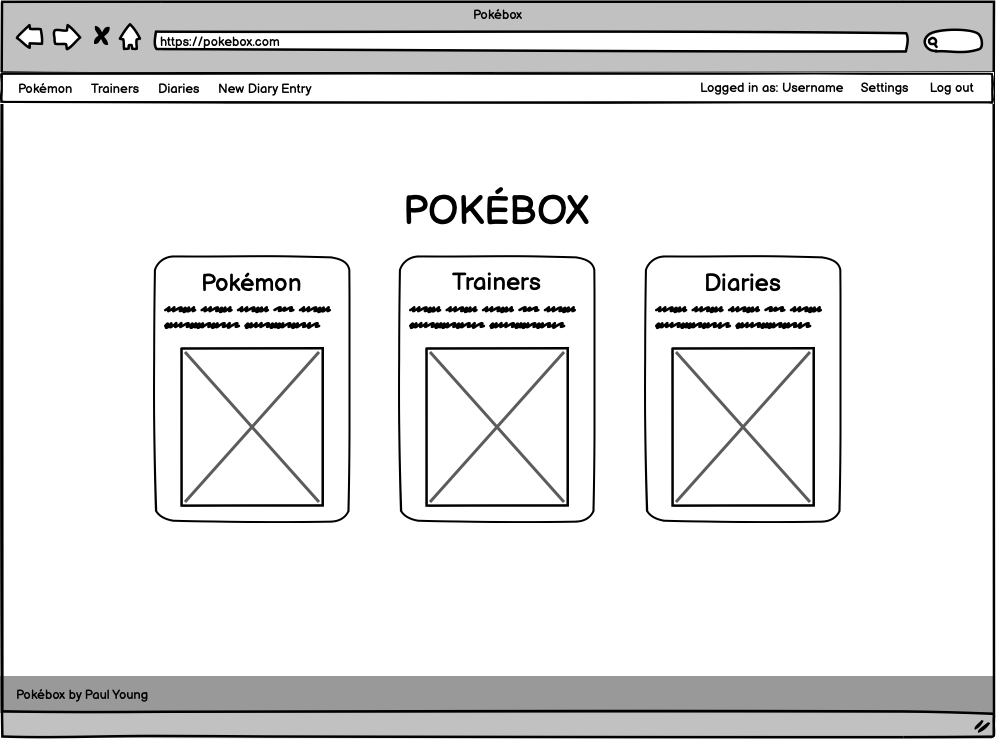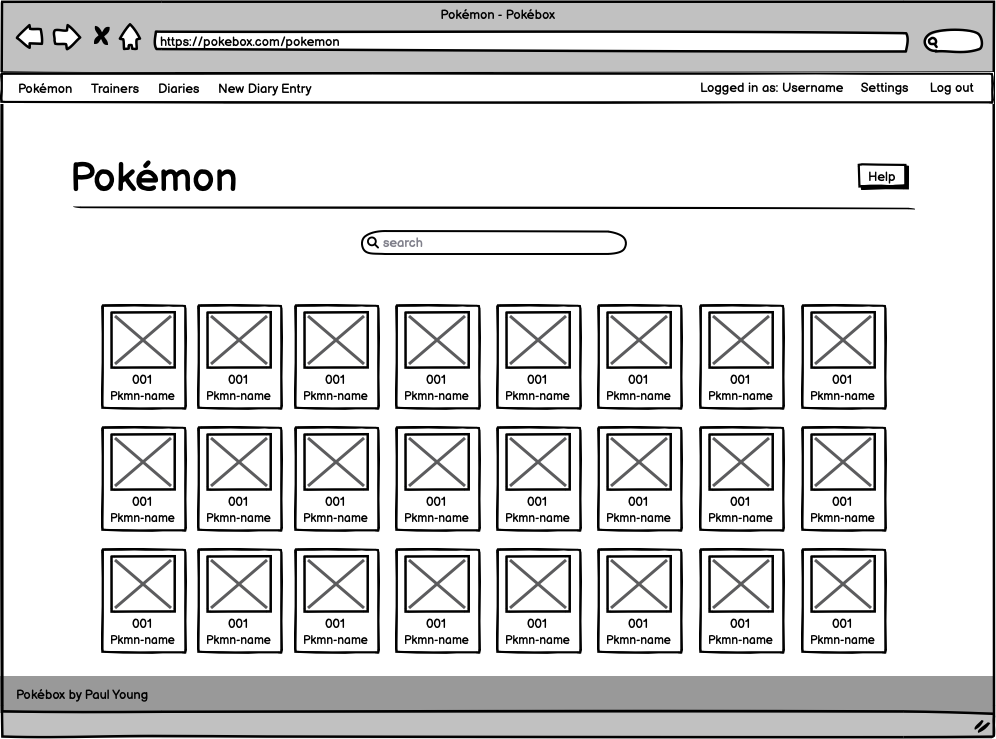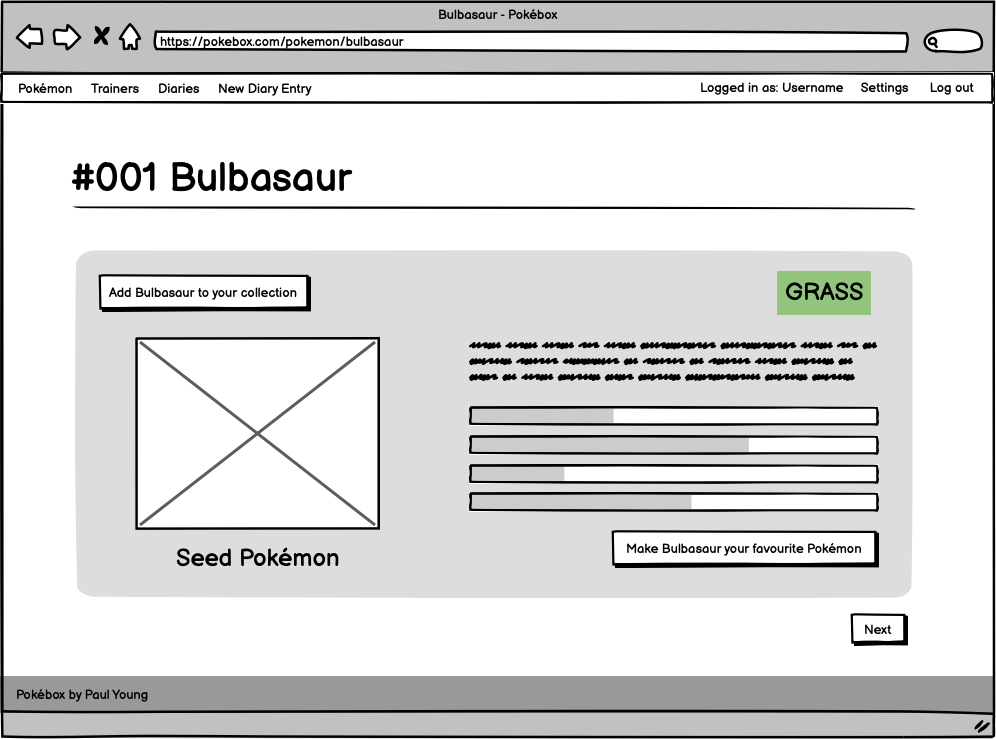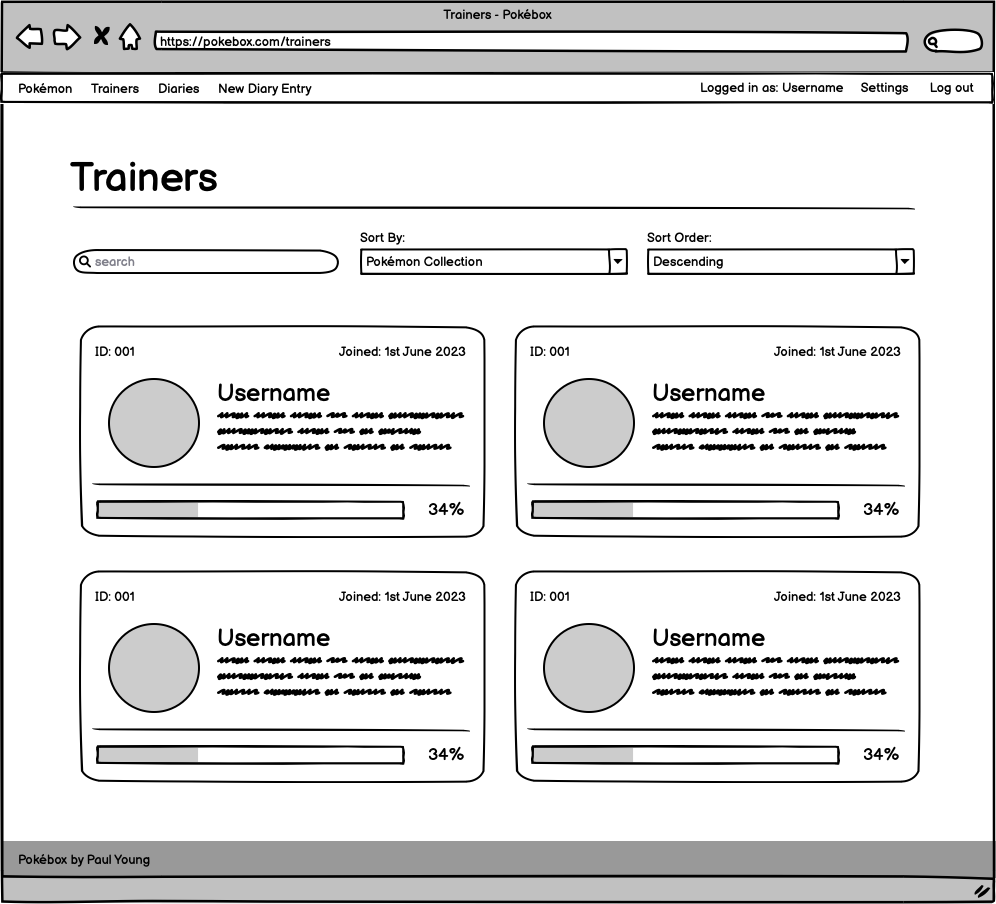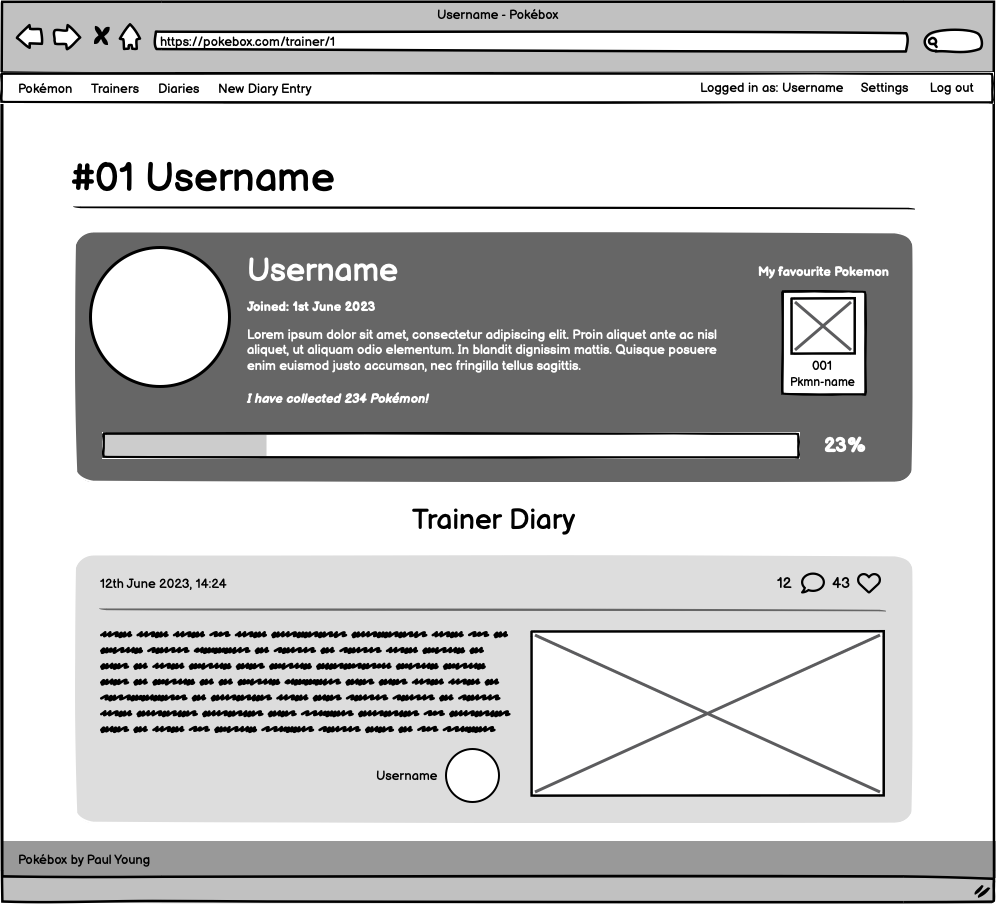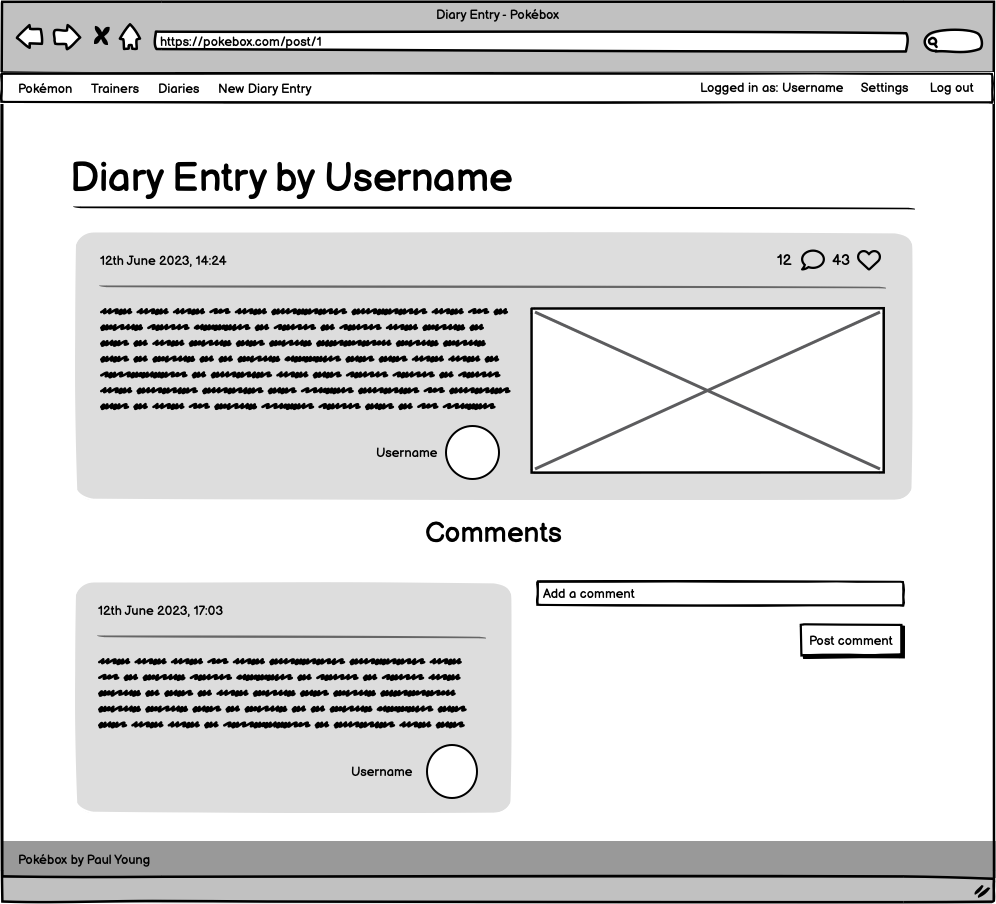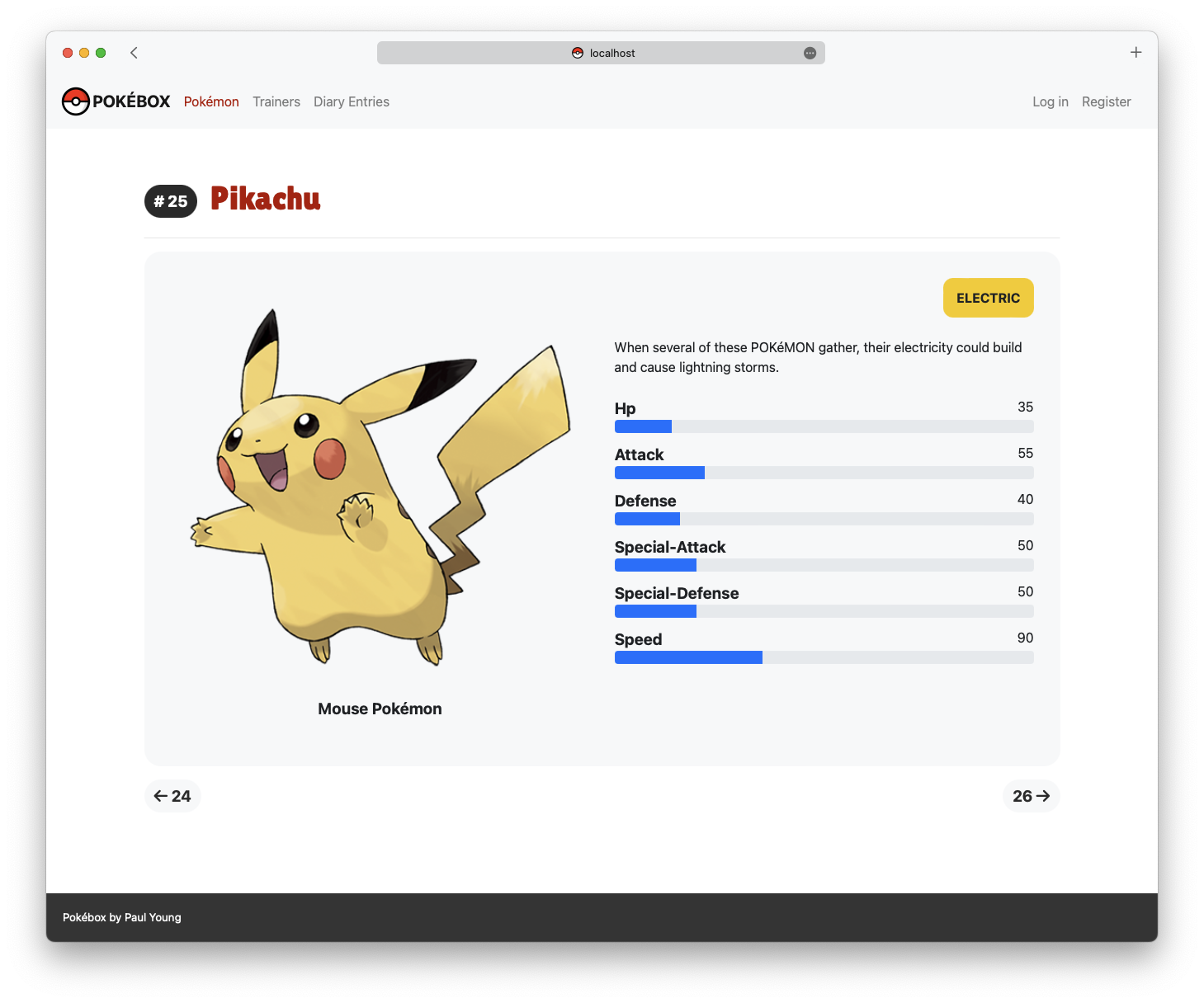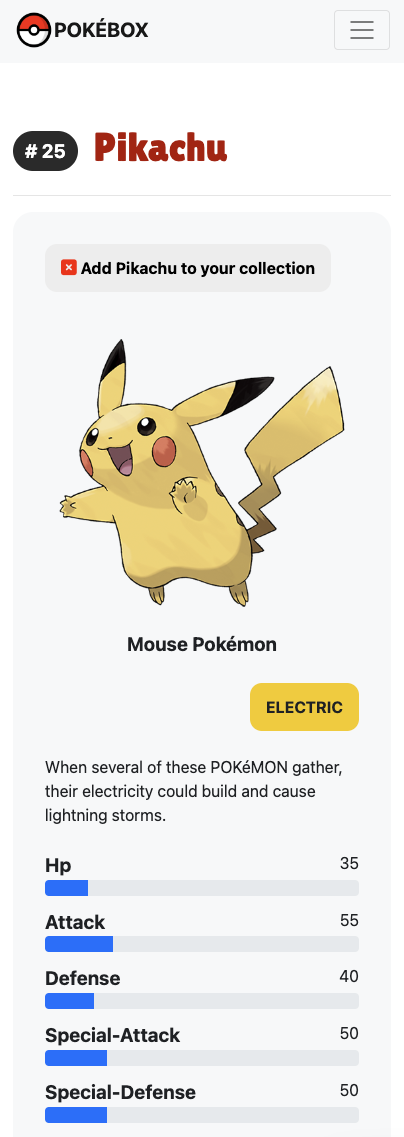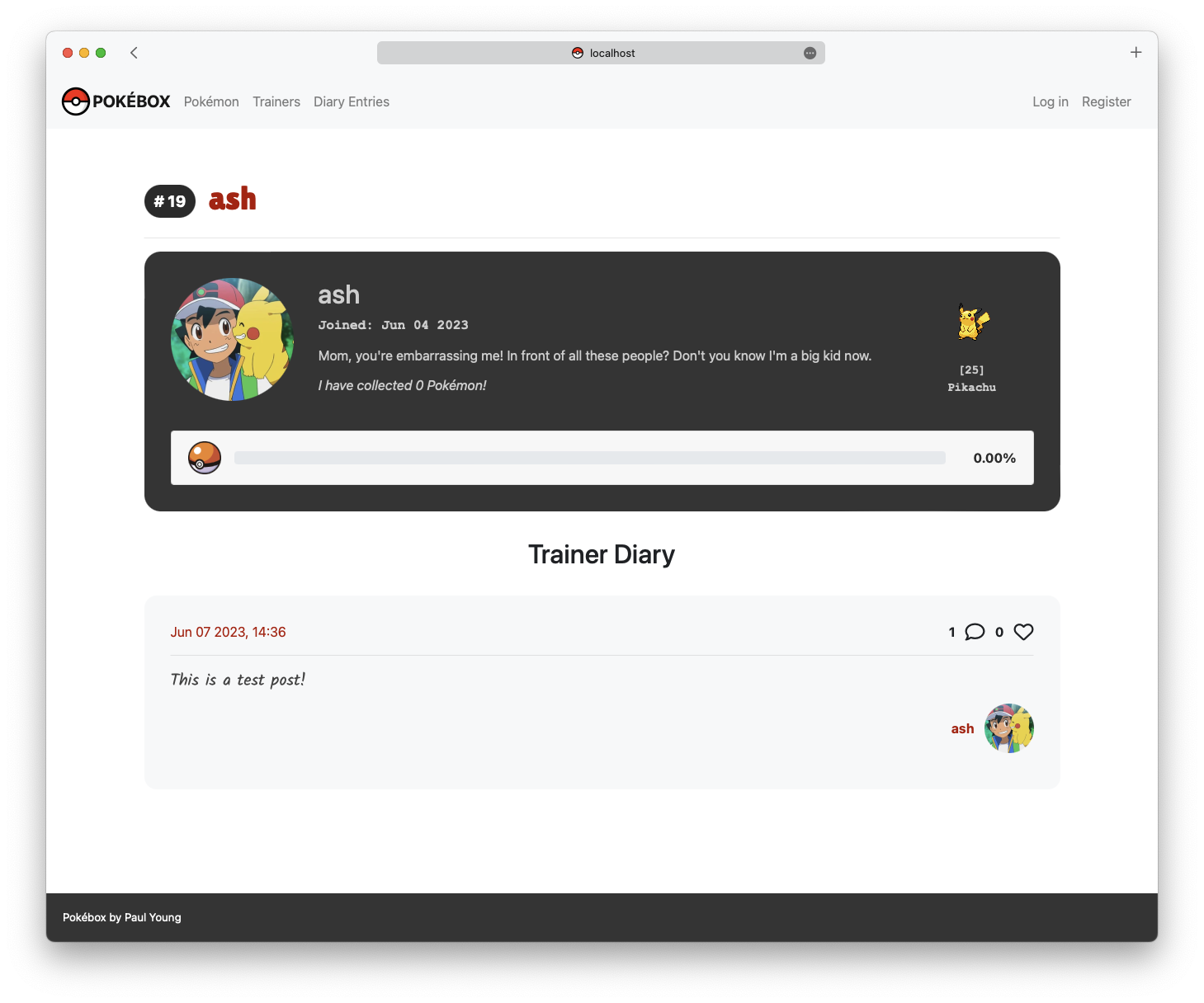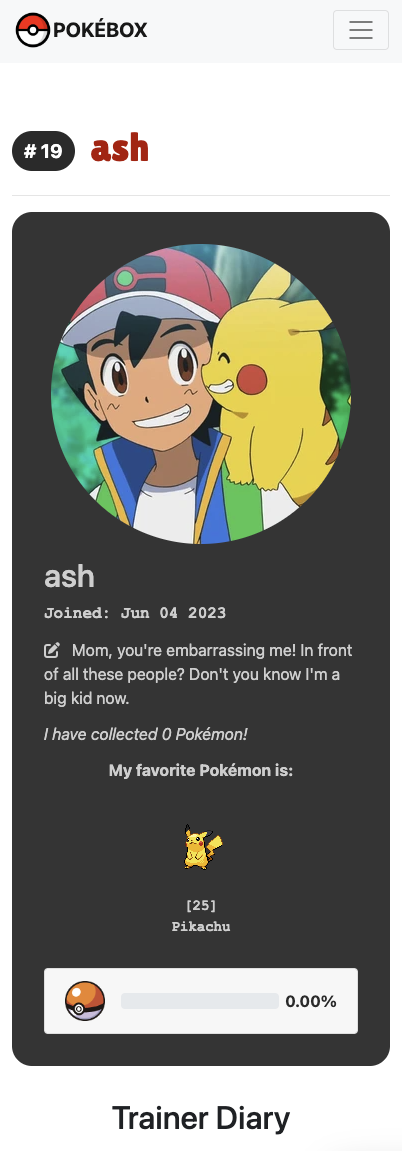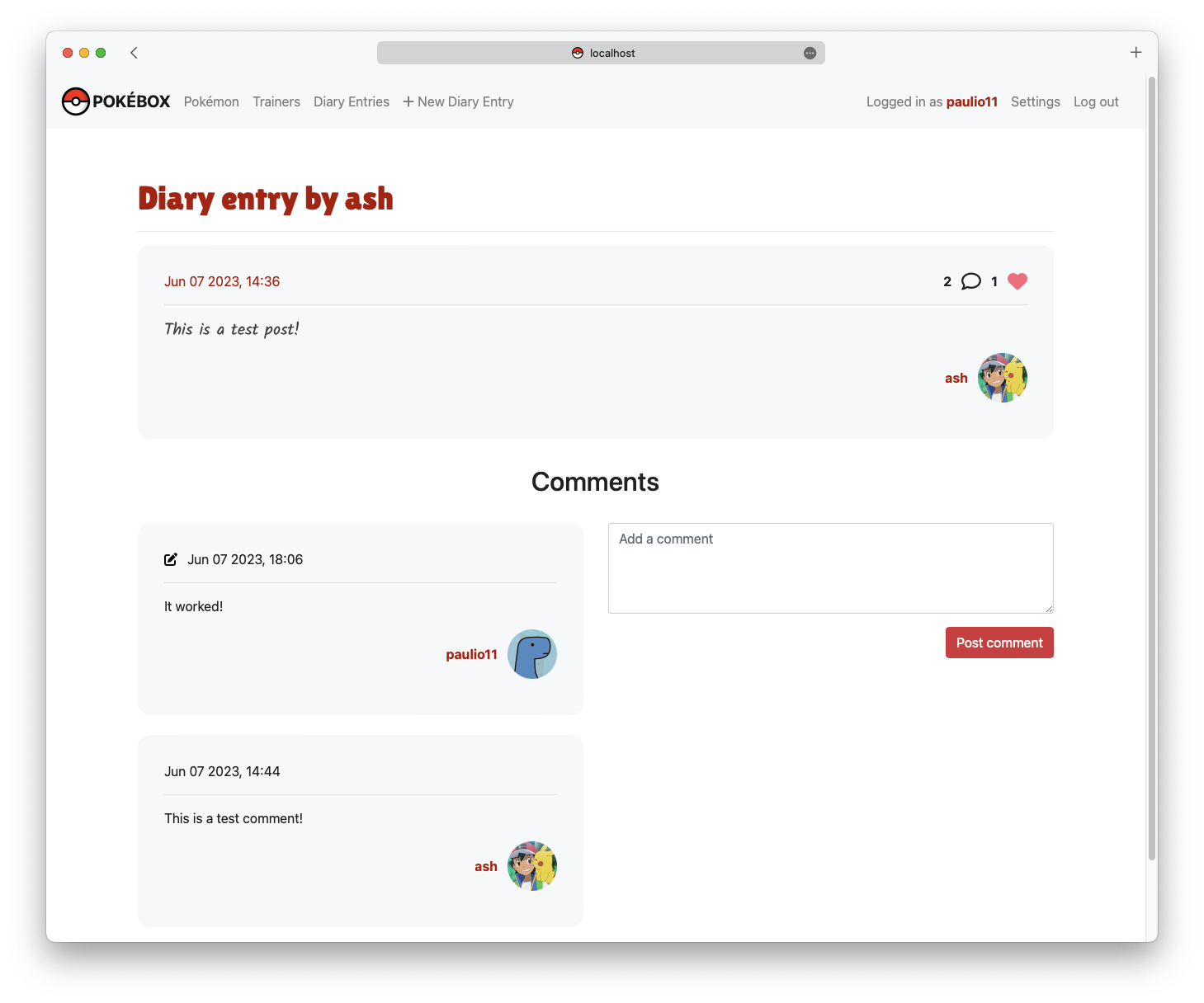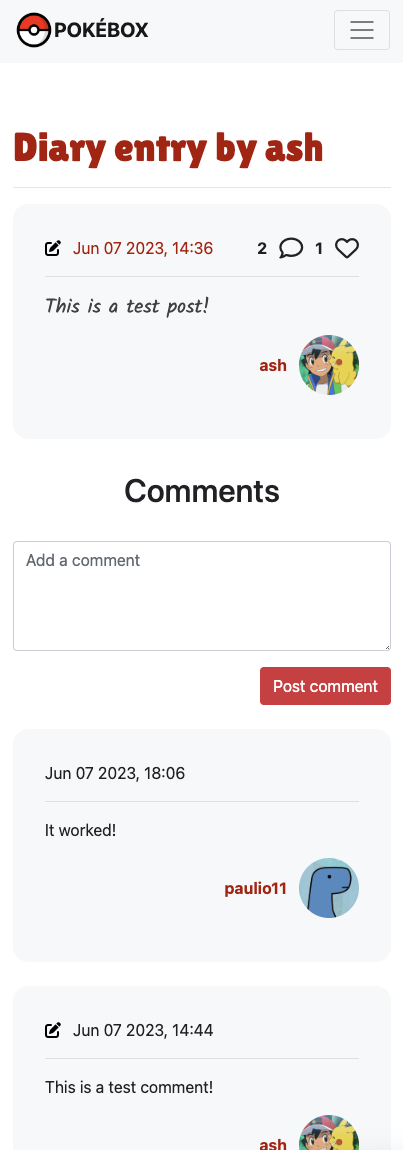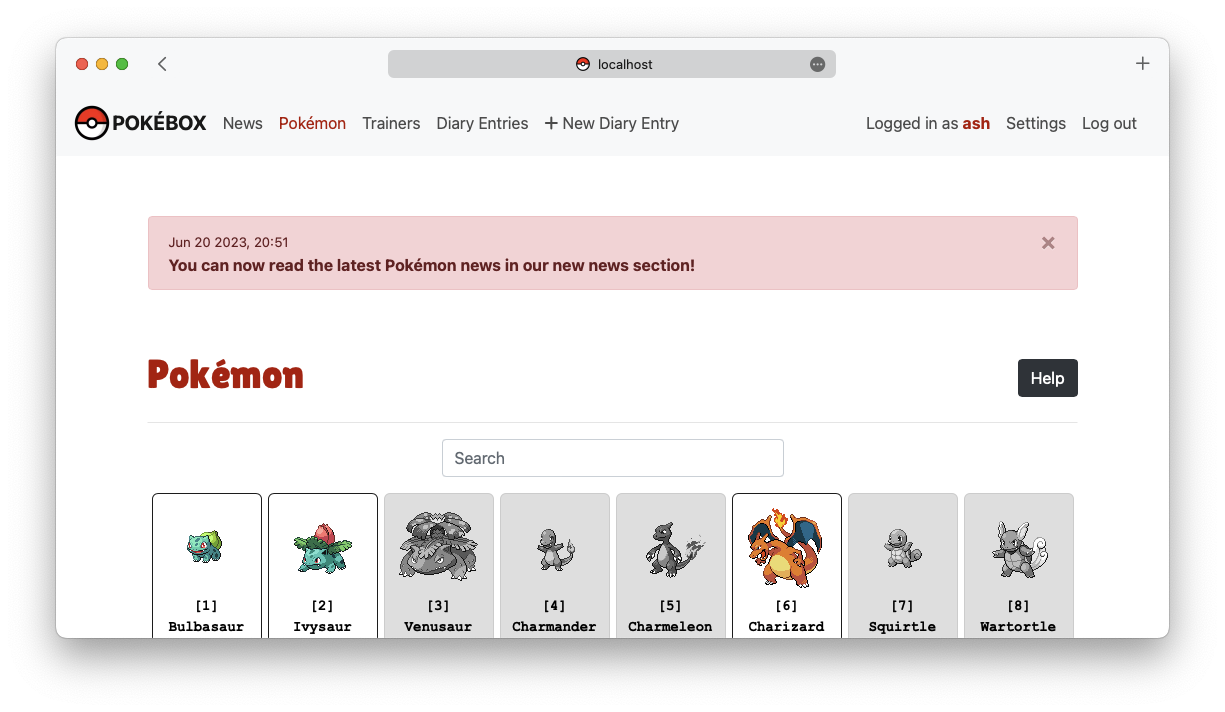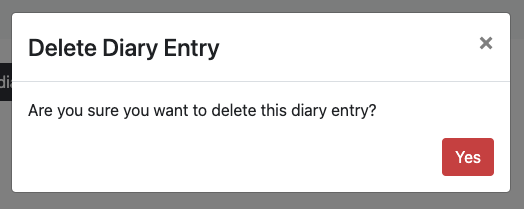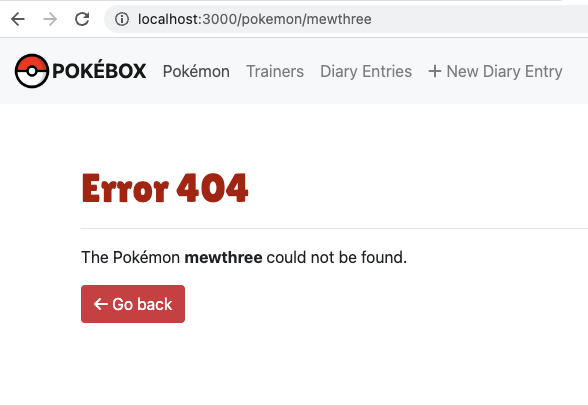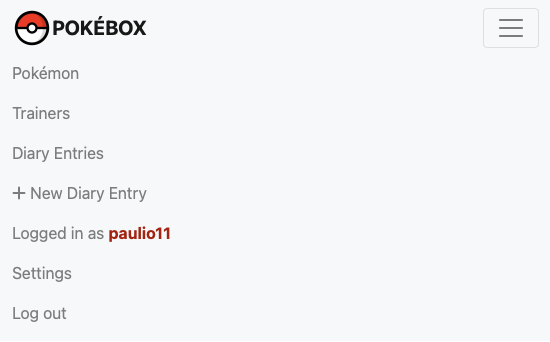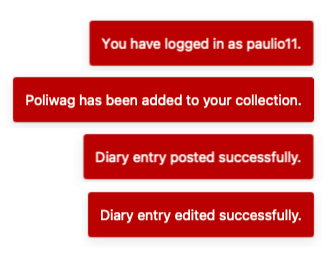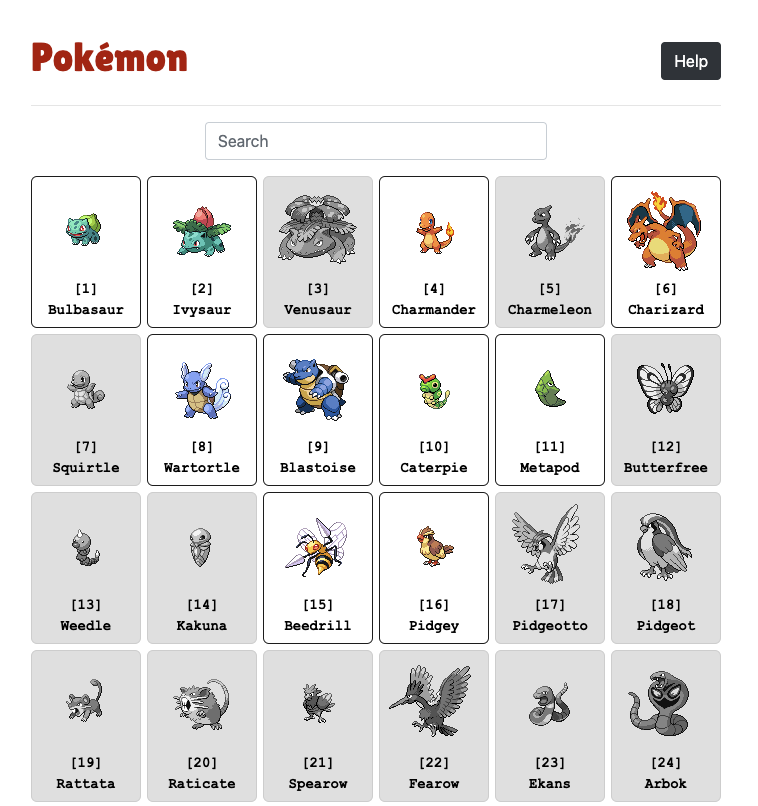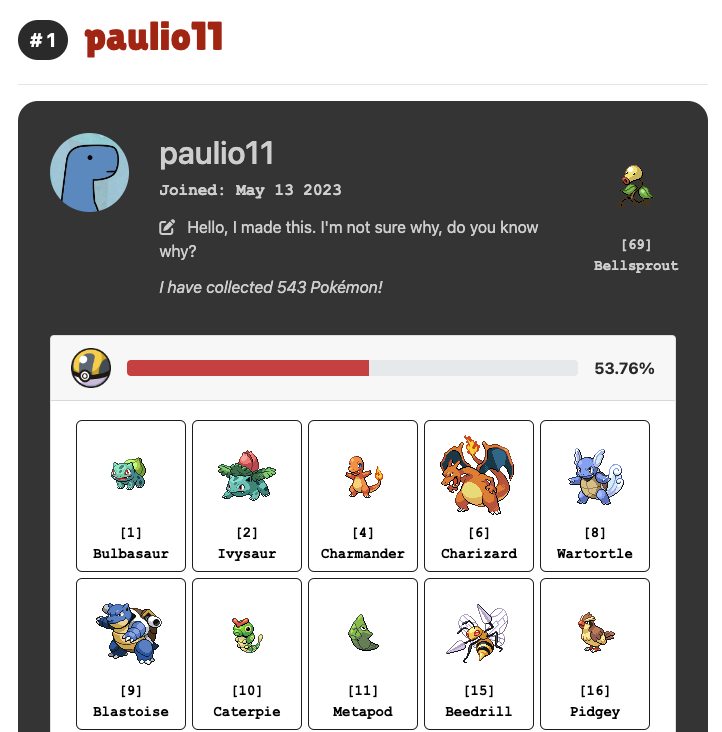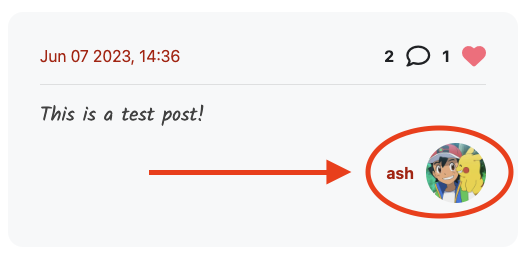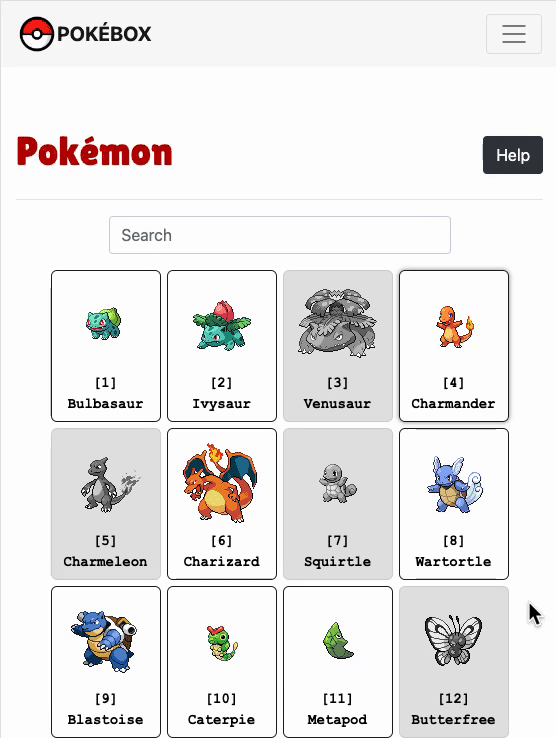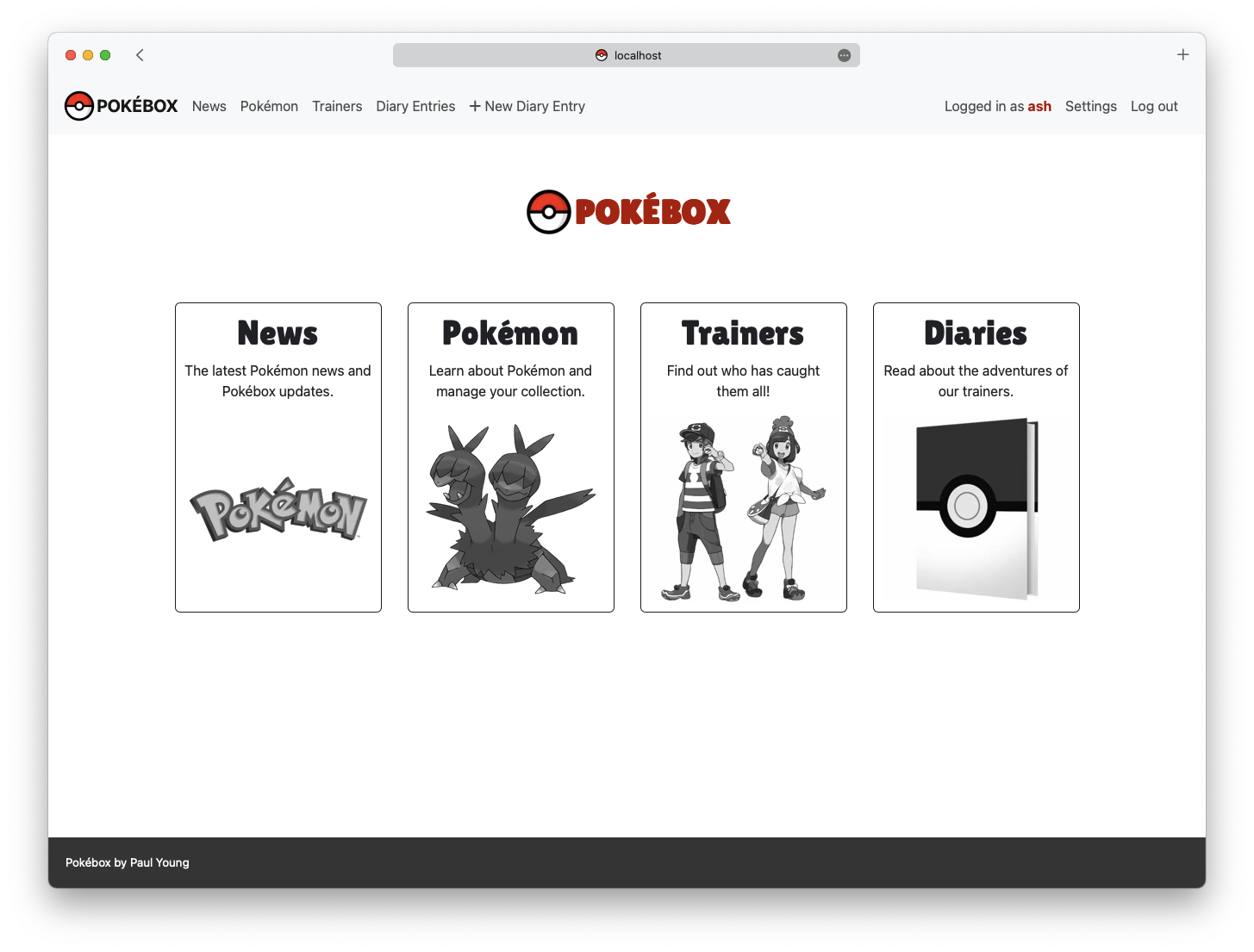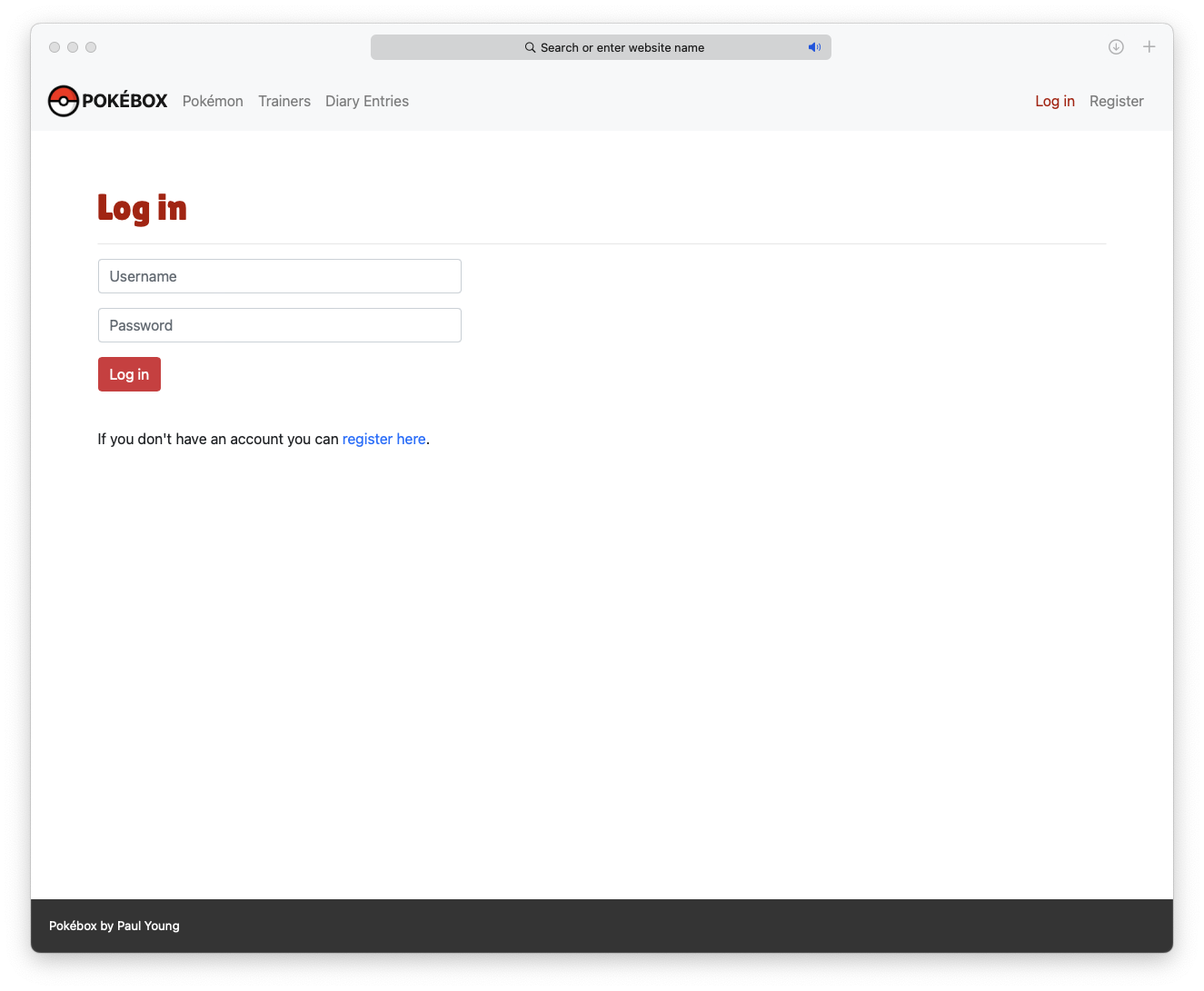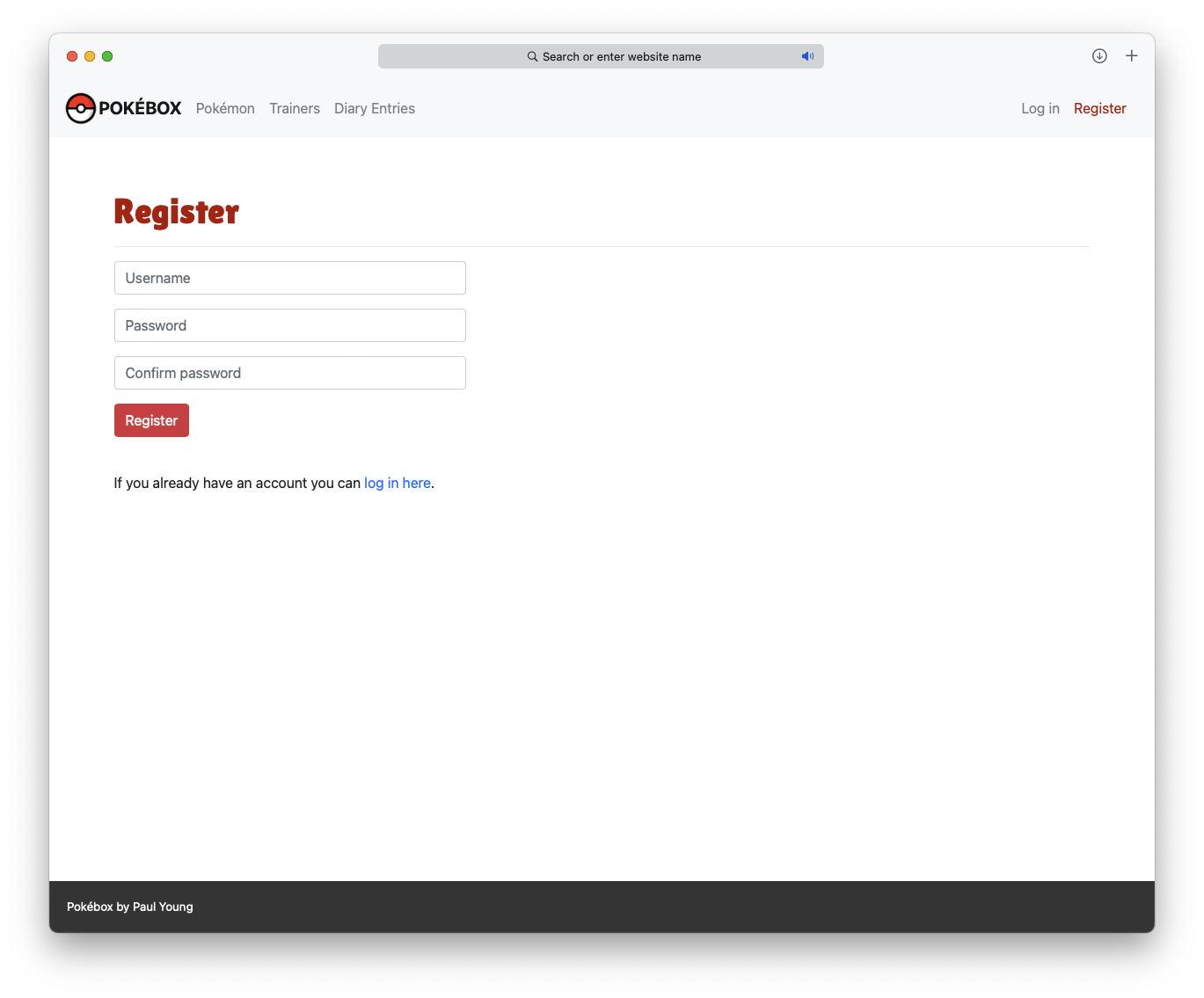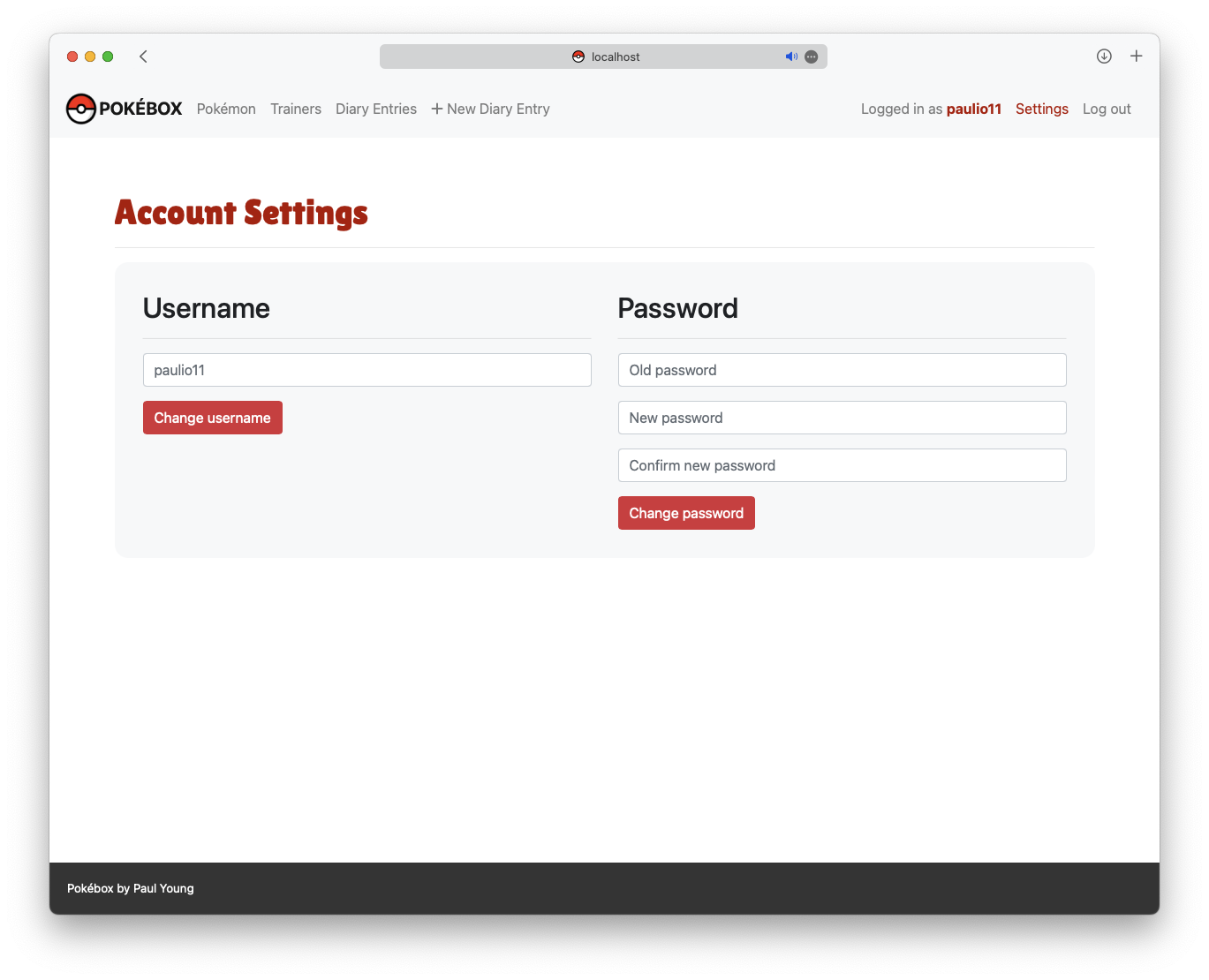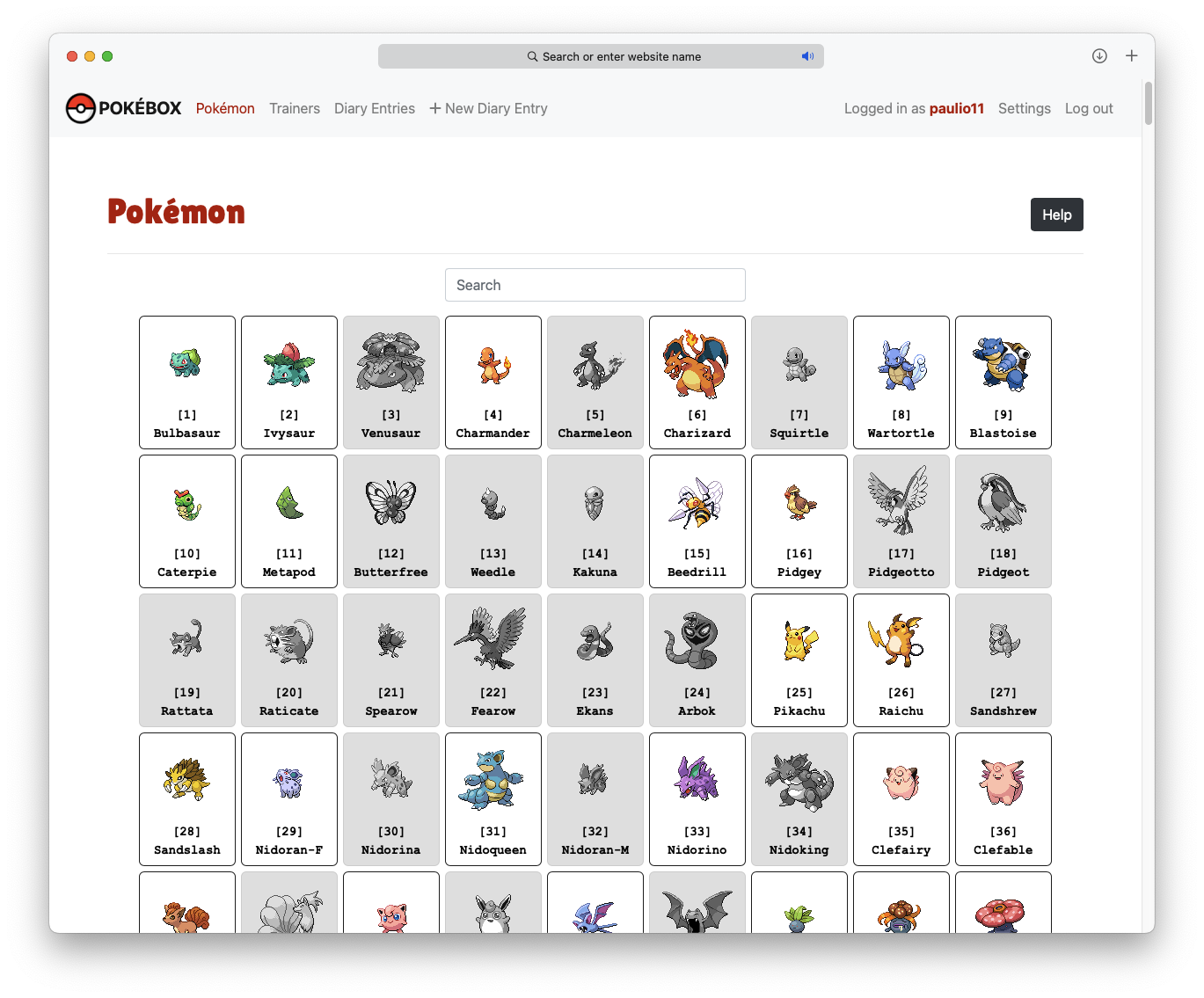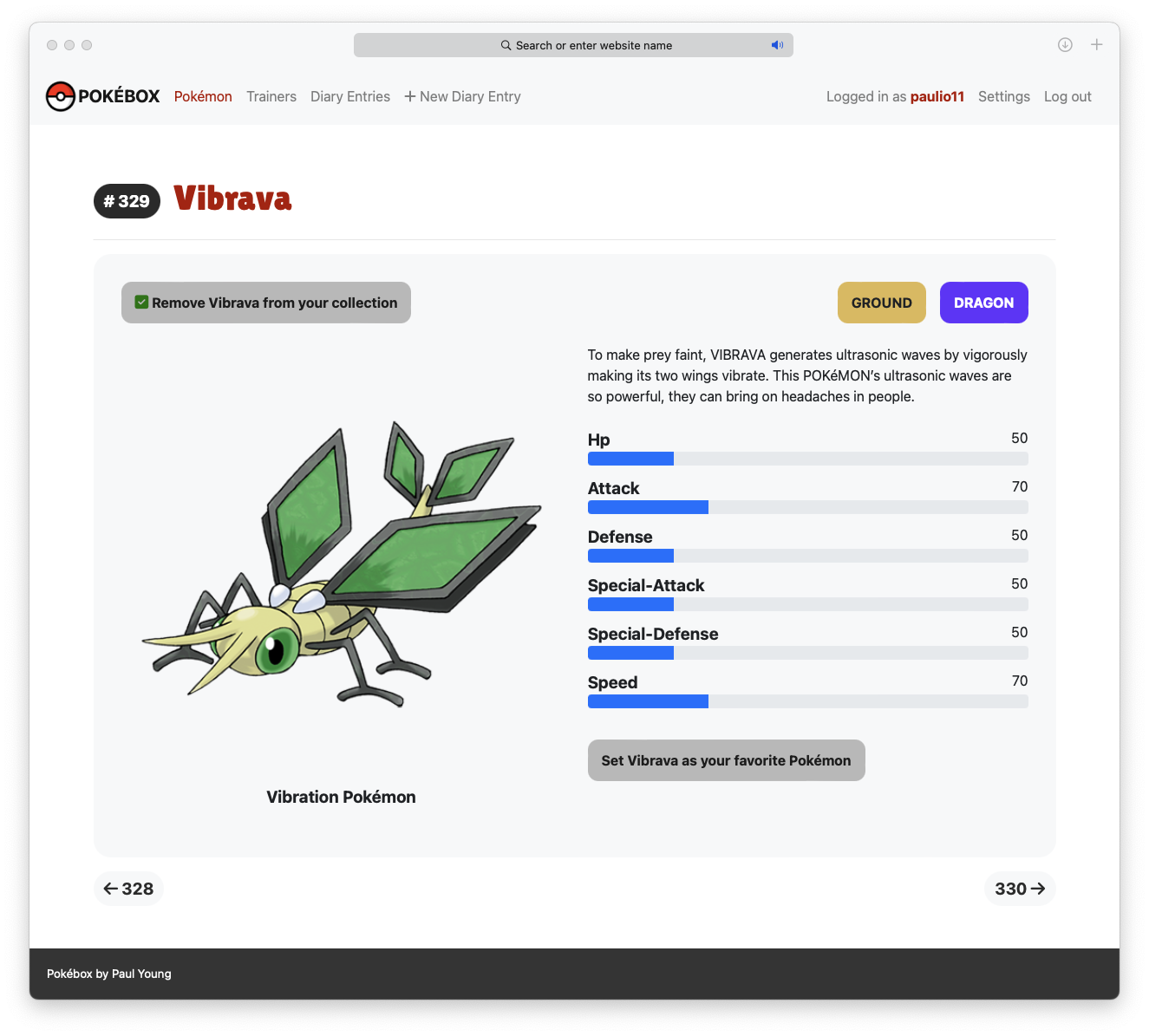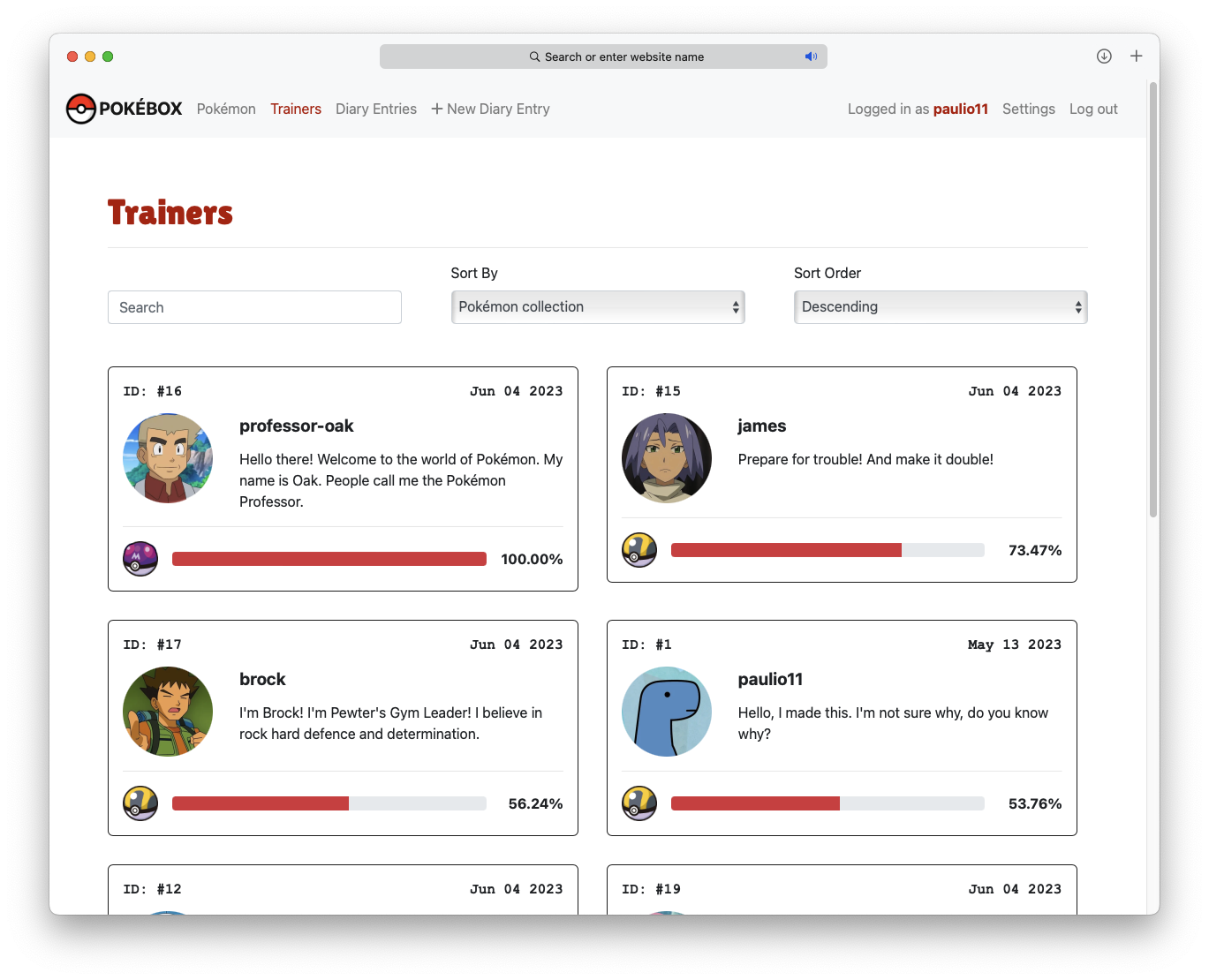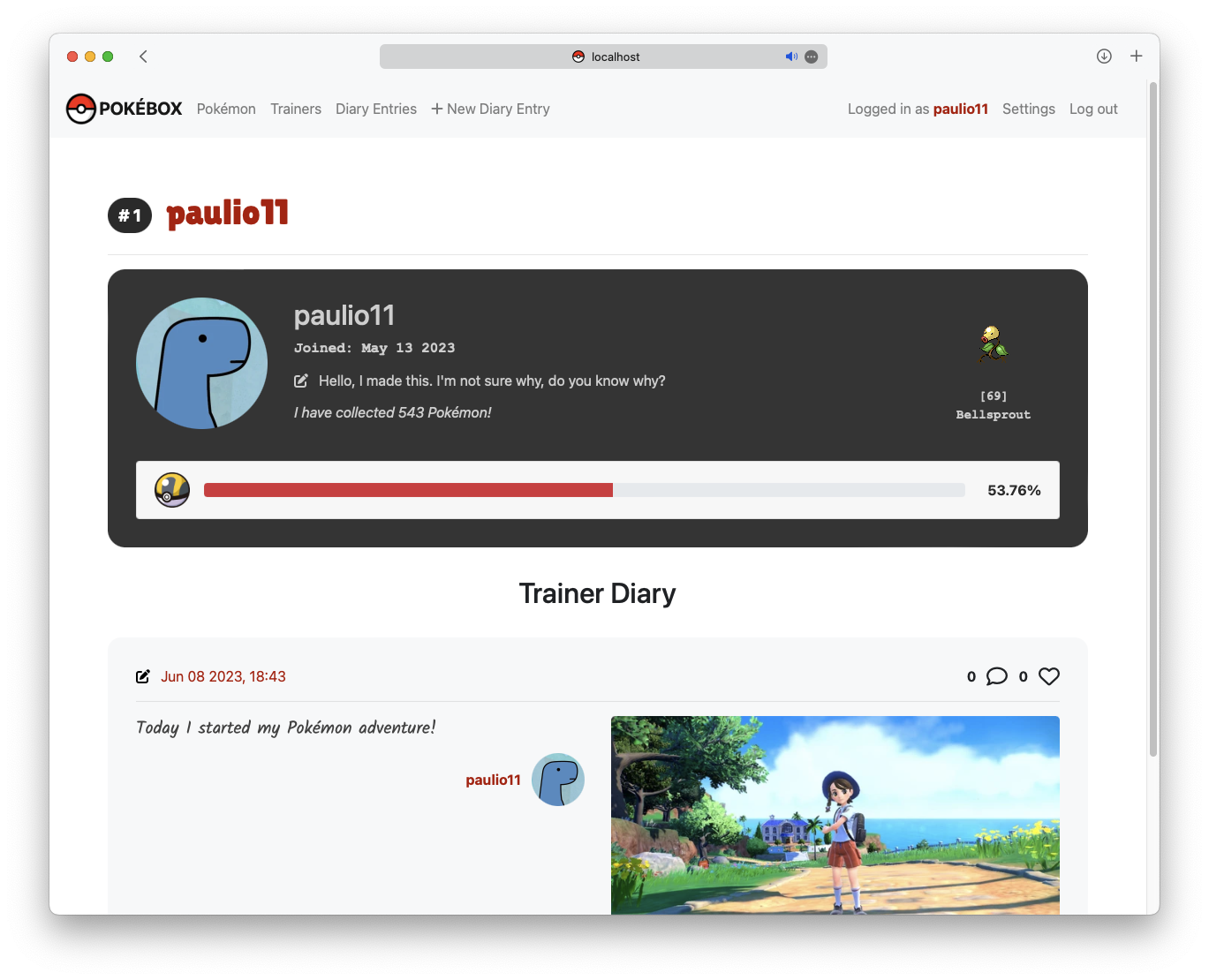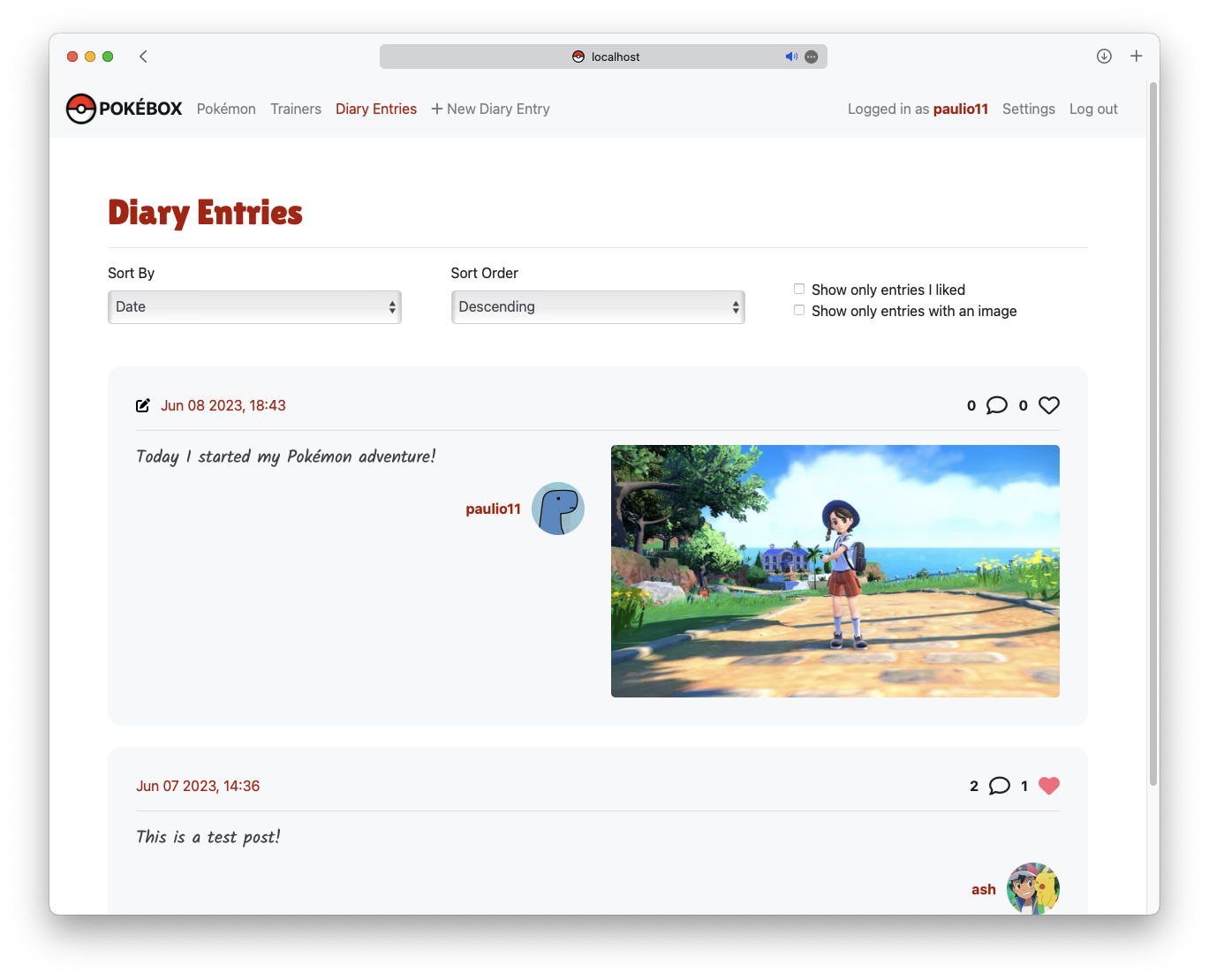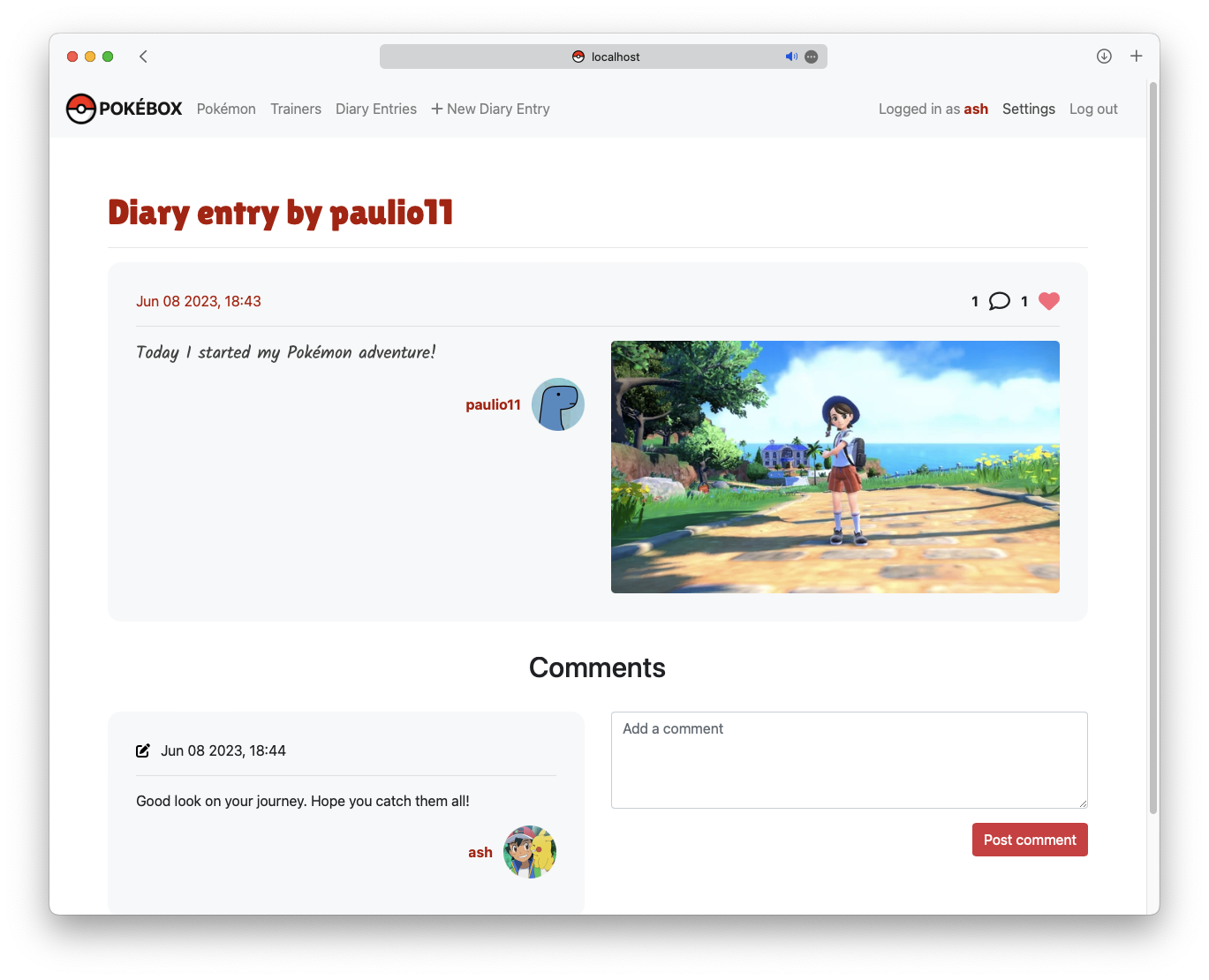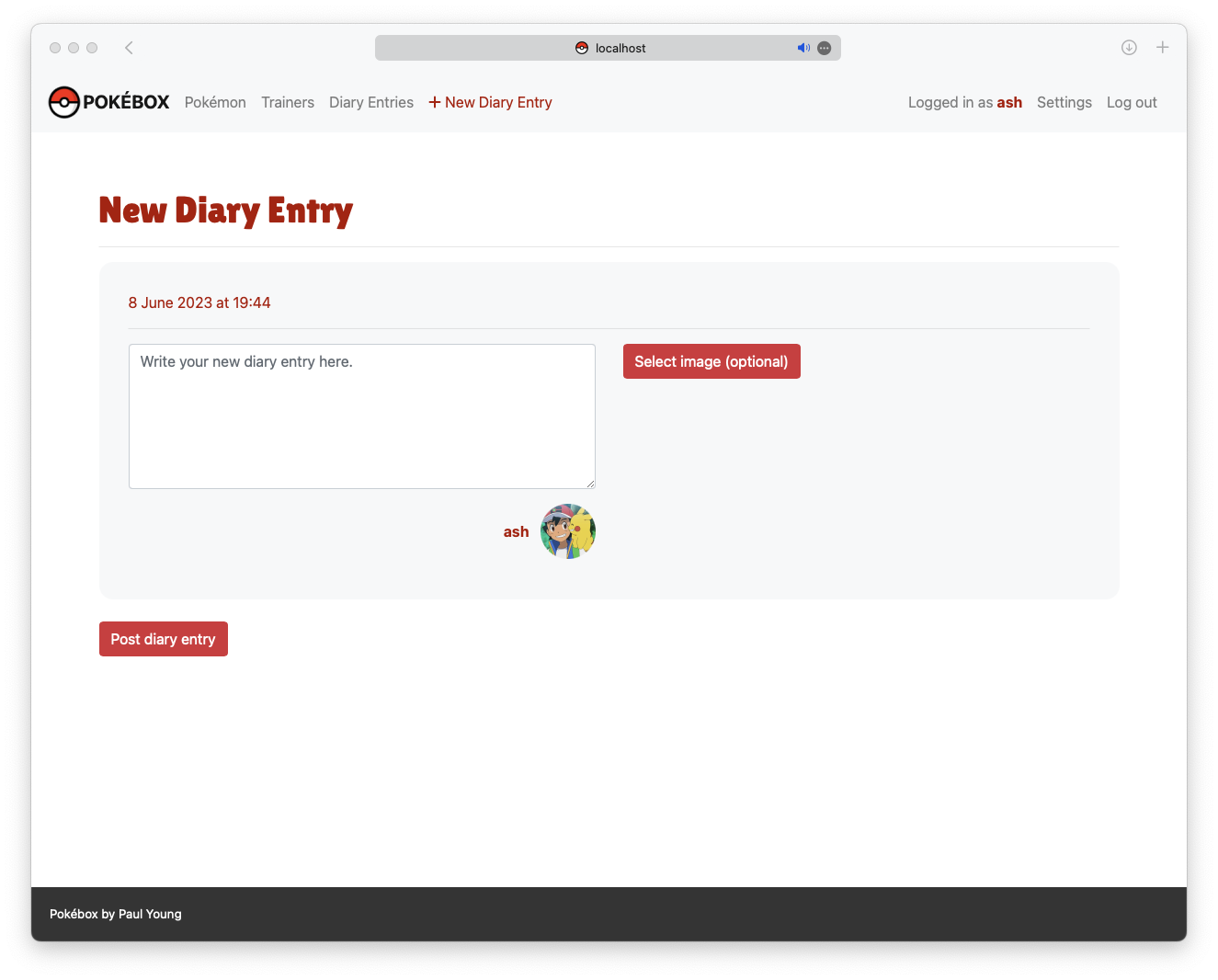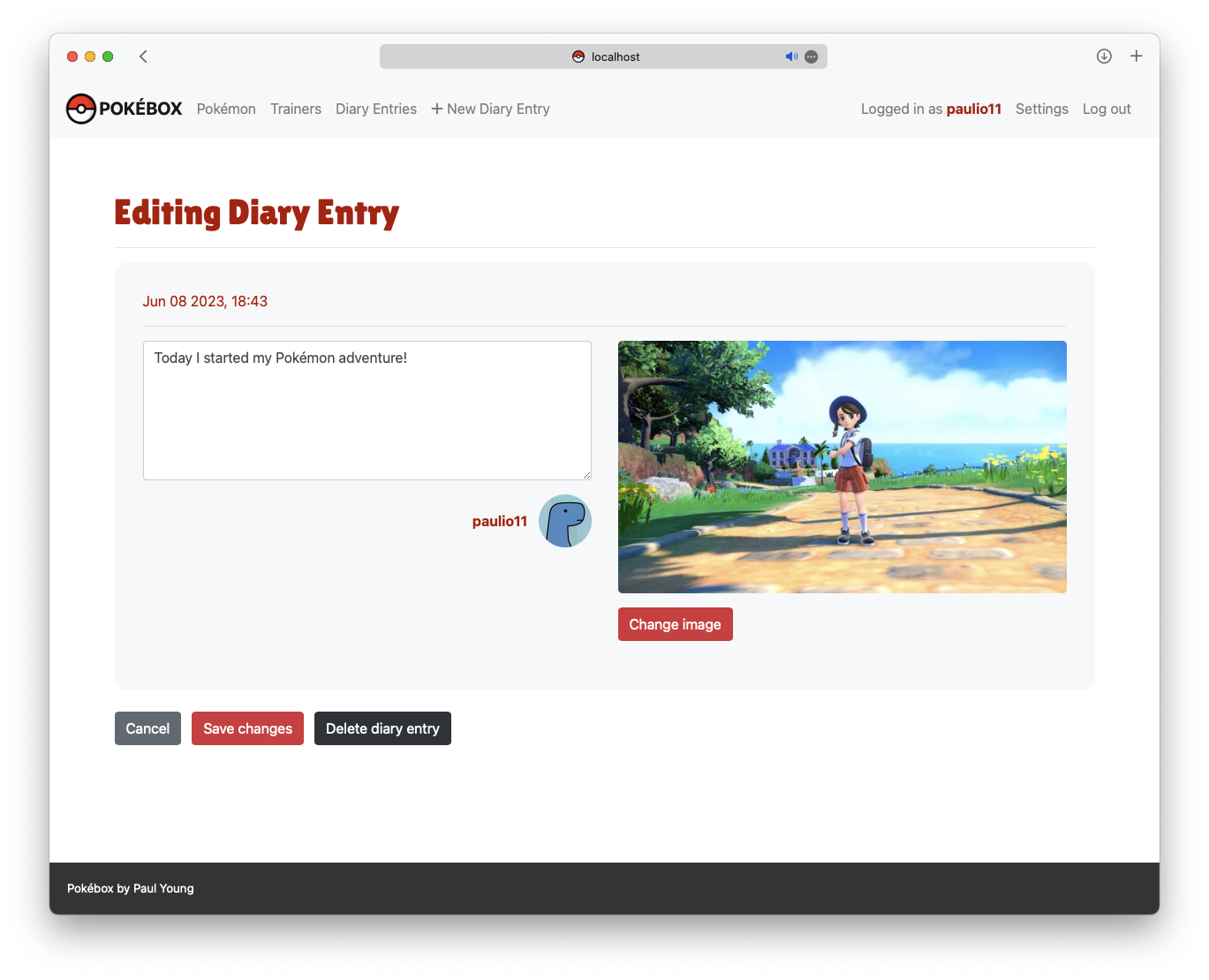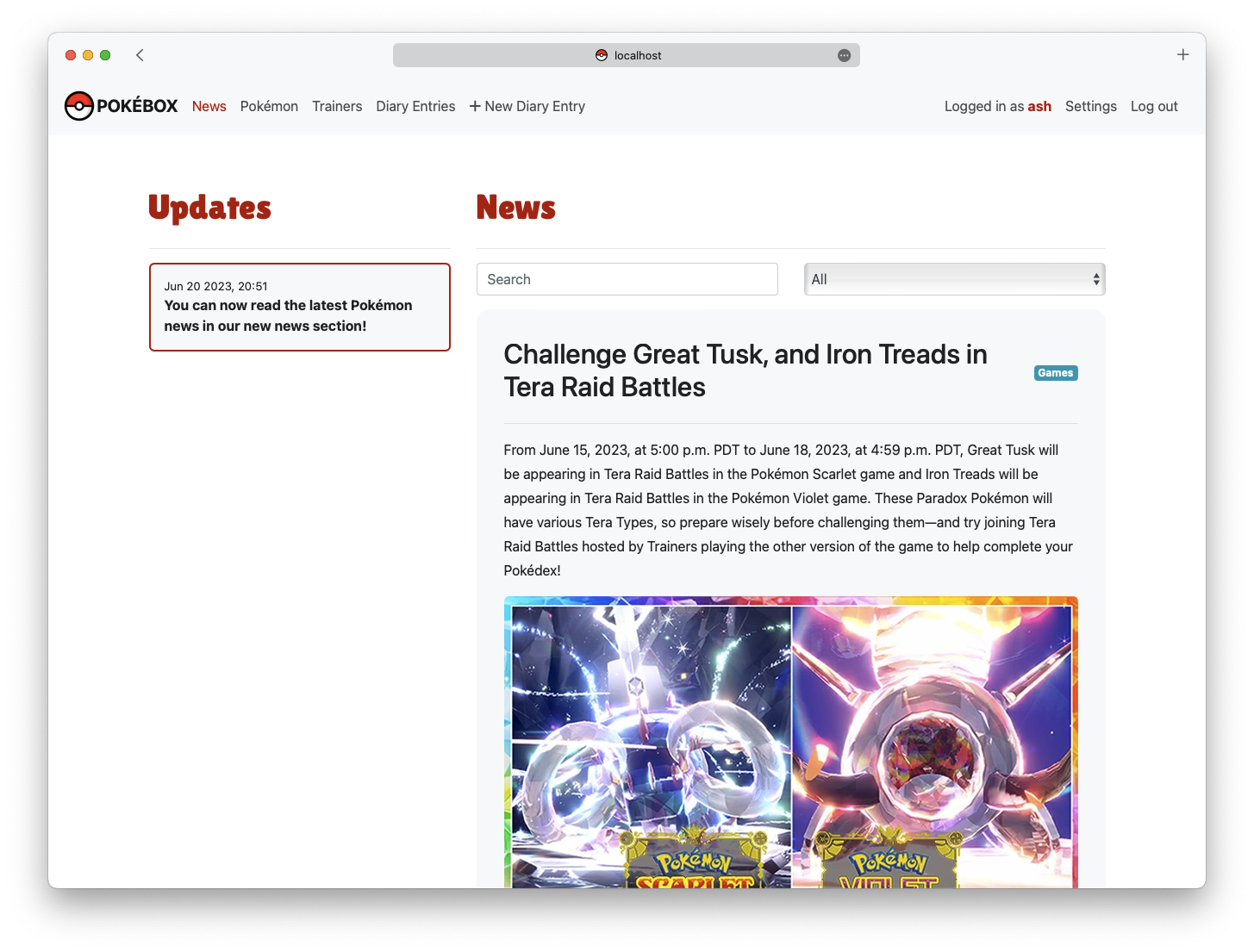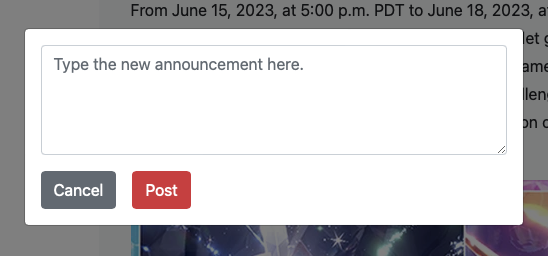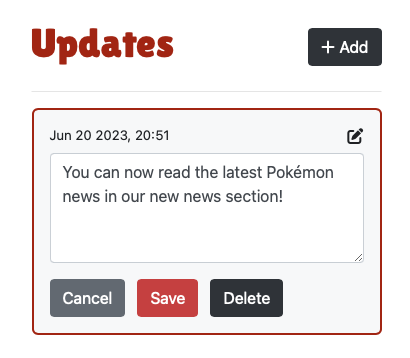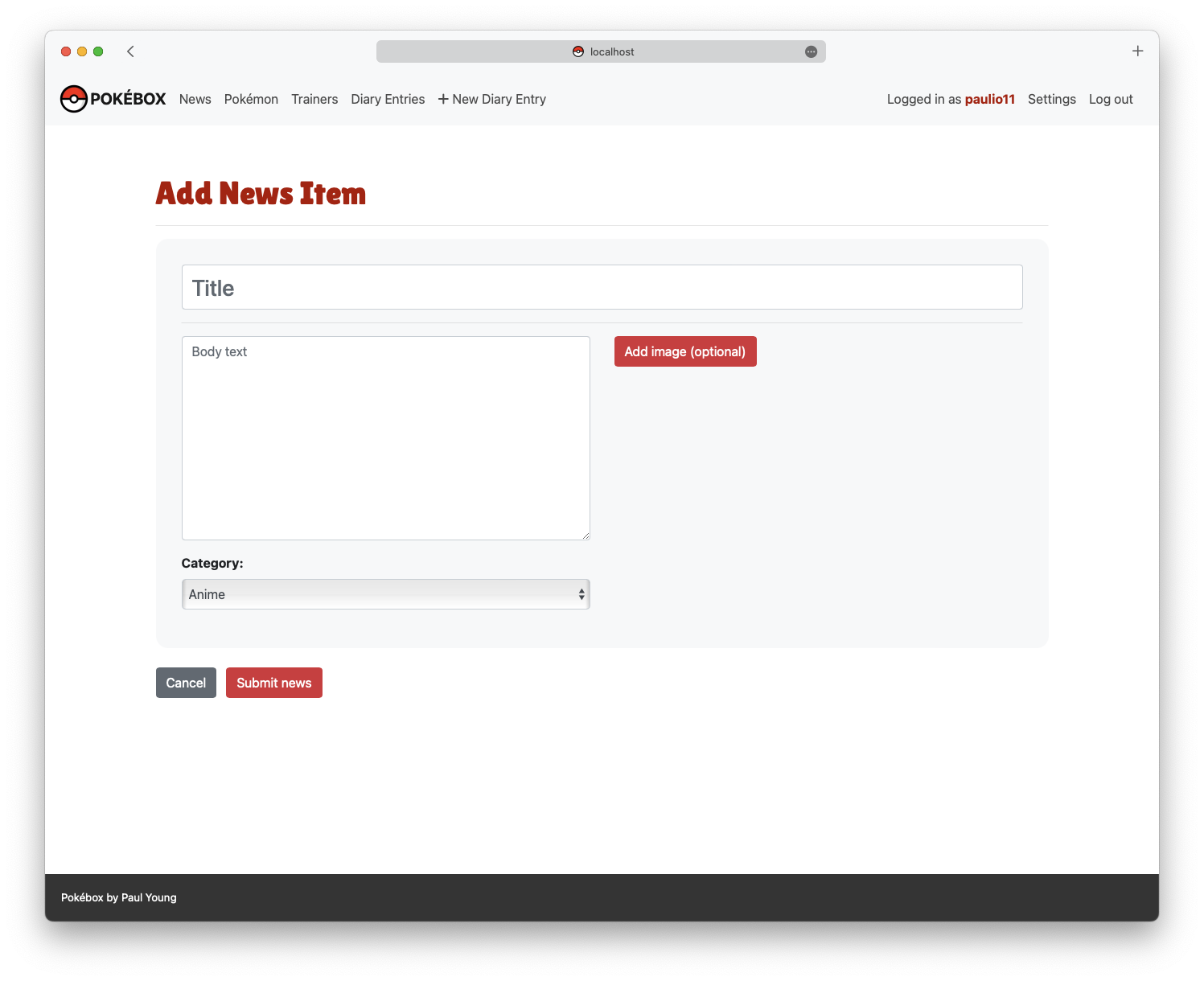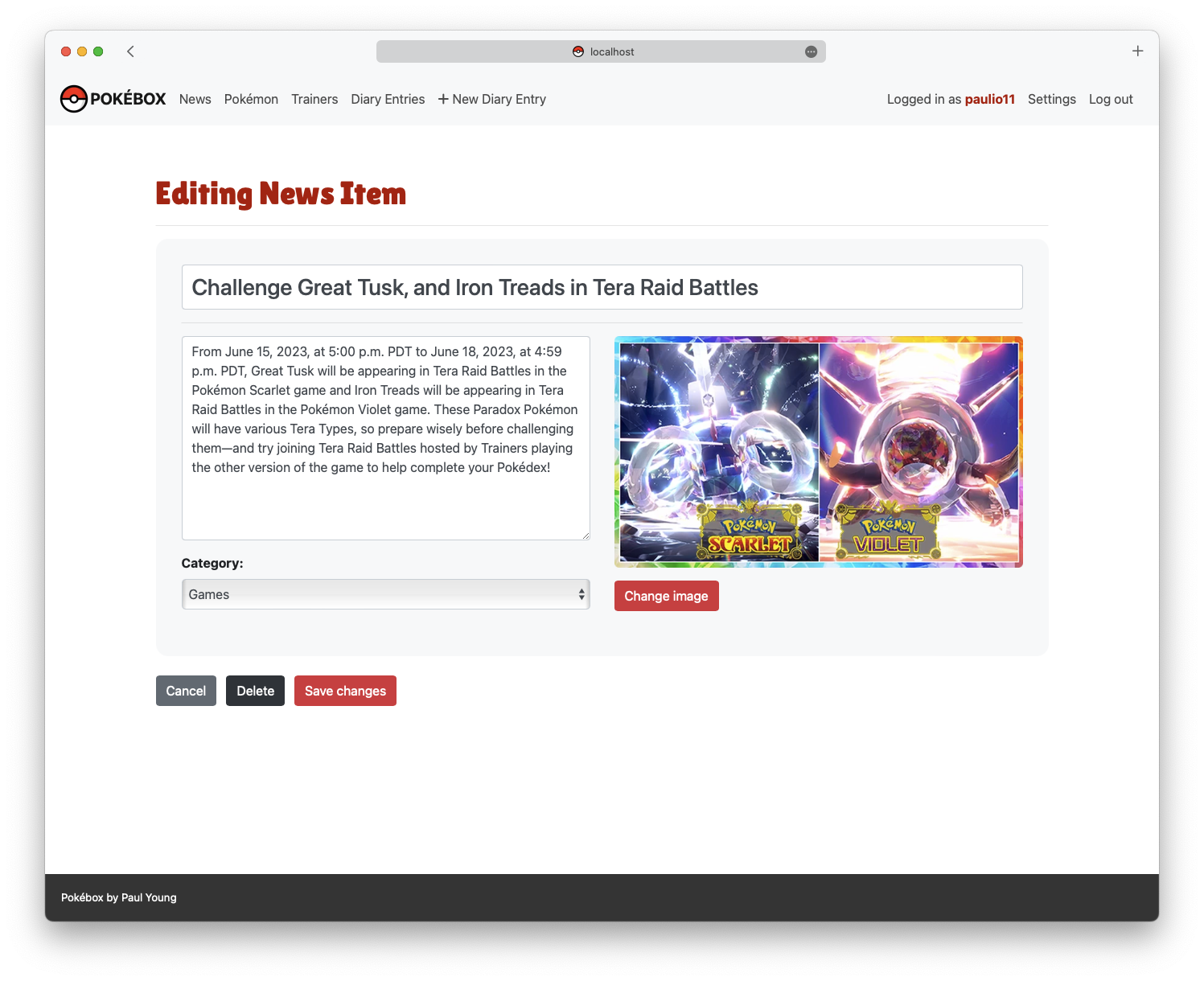- Introduction
- Project Planning
- User Experience
- Features
- Bugs and Fixes
- Technologies
- Testing
- Deployment
- Credits
Pokébox is a user-friendly website that allows Pokémon enthusiasts to easily keep track of their Pokémon collections. The website is built using the popular React framework, providing a smooth and intuitive front-end experience. All data is stored in a SQL database managed by a reliable Django Rest Framework backend. The site pulls accurate Pokémon information from PokéAPI, ensuring that users have access to the most up-to-date data for their collection.
Building a website like Pokébox will offer several benefits for users:
- Organization and Tracking: Pokébox will provide a centralized platform for users to effectively organize and track their Pokémon collection. It will allow users to keep a comprehensive record of their Pokémon, including details like species, stats, types, and more. This can be particularly useful for avid collectors who want to maintain a detailed inventory of their Pokémon.
- Easy Access and Convenience: By having a dedicated website like Pokébox, users will be able to conveniently access their Pokémon collection from any device with an internet connection. This means you can easily manage and view your Pokémon data on-the-go, whether you're using a computer, smartphone, or tablet.
- Community Engagement: Pokébox will foster a sense of community among Pokémon enthusiasts. Users will be able to connect with like-minded individuals, share their collections, and adventures. It will provide a platform for users to showcase their Pokémon achievements and engage in discussions related to the Pokémon world.
- Reference and Information: Pokébox will integrate with PokéAPI, ensuring that users have access to accurate and up-to-date Pokémon data. This will serve as a valuable reference tool for users. Having a reliable source of information should enhance their overall Pokémon experience.
- Latest Pokémon News Updates: Pokébox will feature a dedicated news section to keep users up to date with the latest Pokémon news and announcements. Users can expect to find information on new game releases, events, updates, and other important Pokémon-related developments.
The GitHub project board feature was used to keep track of what I was working on and what still needed to be done. I created a user story for each feature, or an issue for each to do and bug, then moved them when necessary throughout the development of both front and back-end.
Project Board:
There will be two types of users visiting Pokébox. A new or logged out user and registered users. User stories were logged as issues on GitHub to track them through the project (see Project Issues). They were subject to manual testing at the end of the project to determine if I was successful with my objectives. Succeeding in building an application that enables the following user stories will help Pokébox meet it's goals.
| User Story | Achieved? |
|---|---|
| As a new user I can sign up so that I can have my own account and use the full feature set of the website | ✓ |
| As a logged out user I can sign in so that I can return to my account | ✓ |
| As a logged out or unregistered user I can still search Pokébox so that I can find other trainers and/or Pokémon I am looking for | ✓ |
| As a logged out user I can still read a user's diary and comments | ✓ |
| User Story | Achieved? |
|---|---|
| As a user I can view all the Pokémon so I can see what is available | ✓ |
| As a user I can search for a Pokémon to find the one I am looking for | ✓ |
| As a user I can view specific Pokémon so I can see more information | ✓ |
| User Story | Achieved? |
|---|---|
| As a registered user I can edit my avatar so that it can represent me as a user | ✓ |
| As a registered user I can set my favourite Pokémon so that I can show other users what I like | ✓ |
| As a registered user I can set the about text on my profile so I can describe myself to others | ✓ |
| User Story | Achieved? |
|---|---|
| As a registered user I can add Pokémon to my collection so I can grow my collection | ✓ |
| As a registered user I can remove Pokémon to my collection so I can update my collection if necessary | ✓ |
| As a registered user I can display my Pokémon collection so it can be shared with other users | ✓ |
| As a registered user I can see how many Pokémon I have so I can keep track of my collection | ✓ |
| User Story | Achieved? |
|---|---|
| As a registered user I can post an entry to my diary to share something new | ✓ |
| As a registered user I can edit my posts so that I can change them if necessary | ✓ |
| As a registered user I can delete my posts so that I can remove them if necessary | ✓ |
| As a registered user I can add an image to my post so that I can share an image | ✓ |
| As a user I can view my own or another user's diary posts, so that I can see what they are sharing | ✓ |
| User Story | Achieved? |
|---|---|
| As a registered user I can like/unlike someone else's post so that I can show my support | ✓ |
| As a registered user I can comment on a post so that I can start or add to a conversation related to the post | ✓ |
| As a registered user I can edit my comments so that I can change what I said | ✓ |
| As a registered user I can delete my comments so that I can remove them if I want | ✓ |
| User Story | Achieved? |
|---|---|
| As a registered user I can log out so that my account remains secure and private when not in use | ✓ |
| As a registered user I can change my password so that my account can remain secure | ✓ |
| User Story | Achieved? |
|---|---|
| As a user I can sort trainers by the size of their Pokémon collection so I can see who is best | ✓ |
| As a user I can sort trainers by creation date so I can see who is new | ✓ |
| As a user I can sort trainers by name so I can find myself or others | ✓ |
| As a user I can sort diary entries by number of likes so I can find the most liked post | ✓ |
| As a user I can sort diary entries by number of comments so I can find the most talked about post | ✓ |
| As a user I can sort diary entries by date so I can read what is new | ✓ |
| User Story | Achieved? |
|---|---|
| As a user I am alerted to any Pokébox announcements so I am kept up to date with important website news | ✓ |
| As a user I can read the latest Pokémon news so I can keep up to date with the franchise I love | ✓ |
| As a user I can search news so I can find the article I am looking for | ✓ |
| As a user I can filter news articles by category so I can read about the area I am interested in the most | ✓ |
| User Story | Achieved? |
|---|---|
| As an administrator I can create new announcements so that I can keep the website users informed | ✓ |
| As an administrator I can edit announcements so I can change them if necessary | ✓ |
| As an administrator I can delete announcements so I can remove them if they are no longer relevant | ✓ |
| As an administrator I can create news items so Pokébox can be kept up to date with the latest Pokémon news | ✓ |
| As an administrator I can add an image to a news item so that a relevant image can be included | ✓ |
| As an administrator I can define which category a news item belongs to so that an end user can filter news relevant to their interests | ✓ |
| As an administrator I can edit a news item so that I can update it if necessary | ✓ |
| As an administrator I can delete a news item so that it can be removed if necessary | ✓ |
Using MoSCoW prioritization I categorized the features needed to meet the requirements of the user stories into the following categories:
The final version of Pokébox must include the following:
- User sign up
- User log in, log out
- Search for Pokémon
- Manage Pokémon collection
- View Pokémon collection
- Admin users can post announcements
This would produce the minimal viable product.
A more fully feature product would contain these features:
- View Pokémon information
- Read, post, edit and delete diary entries
- View other user profiles and collections
- List other users
- Search for other users
- Admin users can edit and delete announcements
And if there is extra time, these features could be included:
- User profile customisation
- Commenting on posts
- Viewing, editing and deleting comments
- Admin users can create, edit, and delete news items
- Categorised Pokémon news page
An early version of Pokébox would contain the following - every must do feature, view Pokémon information and view other user profiles and collections from should do, and finally user profile customisation from could do.
Fortunately due to the length of this project I was able to produce all of the above features. There are many more possible features I might have added given more time. See unimplemented features below.
Balsamiq for Desktop was used ahead of development to plan the basic skeleton of all pages. You can download my wireframes file here.
Fonts are imported from Google Fonts. The font used for all h1 headings is Lilita One. Lilita One is a stylish and bold display font inspired by Art Deco lettering. When used for my titles, it creates a striking contrast with the rest of the text, adding visual interest and emphasis. The rest of the text all uses the same font Segoe UI. Below are two examples of the Lilita One in use.
Home page header:
Page heading:
Besides the Pokémon sprites and art the only other images used on the website are those added by users. These include user avatars and images shared in posts. This keeps the focus where it should be on the Pokémon and the user content. A placeholder image is used in cases where an user has not yet uploaded an avatar. This image is also used as the brand logo and favicon.
Pokébox uses a restrained colour-scheme. The color scheme features a combination of dark and light colors, creating a sense of depth and contrast. The dark red serves as a bold focal point for elements such as links, buttons and headings, while the grays and accent colors add balance and versatility. The majority of colour comes from the images of the Pokémon and user content - again keeping the focus where it belongs.
The website incorporates various Bootstrap components for its design and functionality. When viewed on desktop, the layout follows a two-column structure. However, on smaller screens like mobile devices, the navigation condenses into a user-friendly dropdown menu, and the layout seamlessly transitions to a single-column view. To ensure responsiveness across different screen sizes, Bootstrap containers and columns are employed to handle the layout adjustments. Here are some examples:
I have chosen to use React Bootstrap as the main front-end library for this project because:
- React Bootstrap complements React's component-based approach, offering a rich collection of reusable components for building the user interface.
- It provides a responsive grid system, ensuring the application looks great on different devices without much effort.
- By leveraging Bootstrap's design principles, React Bootstrap enables developers to achieve a polished and modern UI with minimal design work.
- The library benefits from the active React and Bootstrap communities, providing abundant resources and solutions for developers.
- I can easily customize styles and behavior, tailoring the UI to project requirements while building upon the existing components.
- React Bootstrap builds upon the robustness of Bootstrap, a widely used framework, ensuring stability, updates, and long-term support if I choose to further develop Pokébox in the future.
In summary, React Bootstrap was chosen as the main front-end library for this project due to its compatibility with React, responsive design capabilities, consistent and professional look, strong community support, extensibility, and the reliability gained from being built on top of the battle-tested Bootstrap framework.
Pokébox utilizes two powerful APIs to enhance its functionality. The first API is PokéAPI, an exceptional free and open-source RESTful API. PokéAPI offers developers seamless access to an extensive range of data associated with the beloved Pokémon video game series. Through this API, developers can easily retrieve comprehensive information about Pokémon, including details about their species, abilities, moves, types, and much more.
The second API employed by Pokébox is a custom-built back-end API, developed using Django Rest Framework. To explore further details about this API, please visit its dedicated repository.
To talk to these APIs, I use Axios, a JavaScript library that allows making HTTP requests from web browsers. With Axios, I can interact with APIs by sending various types of requests, such as GET, POST, PUT, DELETE, and more.
AxiosDefaults.js contains the necessary options to interact with two APIs. It defines three Axios instances with specific configurations:
pokeApiinstance:baseURLis set as the main PokeAPI endpoint, which is the base URL used for all relative requests.- The
Cache-Controlheader is set tono-cacheto resolve frequent data-fetching issues. By setting no-cache, failed requests are retried, ensuring fresh data is obtained when the page is reloaded.
axiosReqandaxiosResinstances:- Both instances use the same
baseURL, that of my back-end API, as the base URL for their requests. - The
Content-Typeheader is set tomultipart/form-data, indicating that POST requests use multipart form data. withCredentialsis set totrue, allowing requests to include credentials like cookies, ensuring proper handling of authenticated requests.
- Both instances use the same
Leveraging React in the development of Pokébox enabled me to harness the power of components, which presented numerous benefits such as:
- They can be reused across different parts of the application, saving time and effort.
- Components allow for a hierarchical and organized structure, simplifying the management and expansion of the codebase.
- Components promote clean and modular code, making it easier to understand, update, and maintain the application.
- Specific components can be updated without requiring a full page reload through React's virtual DOM, resulting in faster and more responsive user interfaces.
Each page and component actively contributes to the attainment of the goals outlined in the project's user stories. The subsequent components listed below are just some of the elements that span across multiple pages:
The announcement component in our app fetches the latest updates from the Pokébox API and displays them in a dismissable bootstrap alert. It's placed below the NavBar in app.js, ensuring users are always up to date, no matter where they are on the site. The component reads local storage keys to check if the user has previously dismissed the alert, allowing them to hide it permanently.
This component is used on both the Trainer List and Trainer Profile pages. It takes the prop size (of the user's Pokémon collection) and returns a different image based on that size. Trainer's with a larger collection of Pokémon have their collection represented by a better Pokéball.
Used in different situations, the modal feature improves user experience in specific areas. It is employed for the help modal on the Pokémon List page, user avatar editing, and confirmation prompts for post and comment deletion.
- It uses the
useStatehook to manage the modal's visibility state. - It defines functions to handle showing and closing the modal.
- The component renders a button that triggers the modal display.
- The modal component includes a header with a close button and a title.
- It also has a body section that renders it's child elements.
This component replaces the whole page if the user tries to navigate to a diary entry, trainer or Pokémon that does not exist. It is returned if the noResults state is true. It will also be rendered if the user visits a route that does not exist.
if (noResults) {
return <Error404 pokemon query={id} />;
}
- The contents depend on the presence of certain properties. If
newsis truthy, it includes the text "news item with ID". Ifpokemonis truthy, it includes the text "Pokémon". Iftraineris truthy, it includes the text "trainer with ID:". Ifpostis truthy, it includes the text "diary entry with ID:". Ifpageis truthy, it includes the text "page you were looking for". Thequeryis displayed within a<strong>element if it exists. The error message concludes with the text "could not be found." - The button when clicked, triggers the
onClickevent handler, which navigates back in the browser history using thenavigate()function.
The Footer component provides a simple div with a contrasting background colour. It is called at the bottom of the main App.js file so it appears on every page. Using the follow CSS rule ensures the footer is always rendered at the bottom of the browser window, Page contains the main bootstrap <Container> and the footer component:
.Page {
height: 100vh;
display: flex;
flex-direction: column;
justify-content: space-between;
}
This provides a bootstrap <Spinner> component with the text "Loading...", center aligned and styled to match the rest of the website. Displayed while the loaded state is false, it gracefully transitions to the fetched data from the Pokébox API or PokéAPI. It also serves as a loader within the <InfiniteScroll /> component.
The NavBar component is a crucial element in the application's UI as it renders a navigation bar that dynamically adapts based on the user's authentication status. By placing it above the main container in the App.js file, it ensures the navigation bar appears consistently at the top of every page, providing easy access to essential links and options for seamless navigation throughout the application.
- It retrieves the current user and a function to set the current user from
CurrentUserContext.js. - The function
handleLogOut()that is triggered when the user clicks on the "Log out" link. It sends a log out request to the Pokébox API endpoint using the axios and then sets the current user to null. - The component also defines two variables:
loggedOutItemsandloggedInItems. These variables store JSX code for the navigation links and options displayed when the user is logged out and logged in, respectively. The links include "Log in" and "Register" when logged out, and "Logged in as [username]", "Settings", and "Log out" when logged in. - Mainly it returns a
<Navbar>component from the React Bootstrap library. It includes the website logo, name, a toggle button for the responsive menu, and two sets of navigation links (one on the left and one on the right) that change based on the user's authentication status. The active link is highlighted using a CSS class.
Expanded Navigation:
Collapsed Navigation:
This component utilizes the useCurrentNotification context (defined below) to efficiently retrieve and present the current notification to the user. Moreover, it incorporates a well-implemented timeout function to automatically clear and remove the notification after a specified duration. To ensure effective communication with either my own API or PokéAPI, the useSetCurrentNotification context function is employed in the majority of catch (error) blocks. This approach guarantees that the user is promptly notified in the event of a possible error.
In addition to error messages, the user will be promptly notified upon successful completion of the following actions:
- Posting, editing, and deleting a diary entry.
- Posting, editing, and deleting a comment.
- Liking or unliking a diary entry.
- Logging in, logging out, and registering.
- Setting their favourite Pokémon.
- Adding or removing a Pokémon from their collection.
- Editing user profile or avatar.
- Changing username or password.
- Creating, editing, or deleting a news item.
- Creating, editing, or deleting an announcement.
Examples of notifications:
The component plays a crucial role in three sections of the application: the Pokémon list, the user's collection, and the favorite Pokémon display. Within these areas, it efficiently renders vital information for each Pokémon, including the sprite, ID, and name. Moreover, users can conveniently add or remove a Pokémon from their collection by simply right-clicking on this component while on the Pokémon List page.
- It manages the
collectedstate using the useState hook, initially set to false. Then utilizes theuseEffecthook to update collected based on the user's Pokémon collection. - It defines a
handleRightClick()function to handle the right-click event, preventing the default behavior and instead it updates the user's Pokémon collection. - The component handles styling based on whether the Pokémon's ID exists in the user's Pokémon collection array. This approach reflects the collected status of the Pokemon to the user, enhancing the visual representation of their collection.
- Clicking the component navigates the user to the relevant Pokémon Information page.
The Pokémon component used on the list page, reflecting collected status:
The Pokémon component used on the trainer page, representing the trainer's favourite Pokémon and collection:
This component is utilized at the bottom of every post and comment, as well as on the New Diary Entry page. When employed at the bottom of a post or comment, it shows the username and avatar of the owner, linking to their profile. On the new diary entry page, it showcases the username and avatar of the currently logged-in user (obtained from the current user serializer), providing a preview of how their entire post will appear.
ToTopButton creates a button that becomes visible as the user scrolls down, and when clicked, it smoothly scrolls the page to the top. The button's visibility is controlled using the useState hook and updated based on the scroll position with the handleScroll function. The useEffect hook is used to add or remove a scroll event listener. The component returns a button labeled "Top". It is used in the main App.js file to ensure it appears on every page.
The pages Pokébox use are sorted into the following directories/categories, each directory contains its own unique components:
- Authentication and Account pages
- Trainer Diary pages
- Pokémon pages
- Trainer Profile pages
- News pages
The home page employs a clean and straightforward design that effectively highlights the three main uses of Pokébox. Each element serves as a link, seamlessly directing users to the relevant page. The Pokémon section features a randomly chosen image, selected using the generateRandomNumber() function. This function generates a random number between 1 and 1010, representing the total number of Pokémon, and uses it to display a random Pokémon image. This element adds an element of surprise to the otherwise static home page.
Login and Registration
Login.js is responsible for rendering a login form and handling the submission of login credentials to Pokébox API.
- It creates two state variables:
logInDataanderrors. LogInData is an object that holds the username and password entered by the user in the login form. Errors is an object that will store any errors returned from the server during the login process. - The
handleSubmit()function makes an HTTP POST request to the log in endpoint with the logInData object as the request payload. If the request is successful, it takes the data from the response, and calls thesetCurrentUser()function to set the current user. It then navigates to the user's profile page. - If the request returns an error it is displayed as a bootstrap
<Alert>to the user.
In mostly the same way as Login.js, Register.js manages user registration. Capturing their username and passwords, sending the form data to the API endpoint for registration, and displaying any validation errors. It also provides navigation to the login page upon successful sign up.
The Settings component represents an account settings page where the current user can update their username and password. It utilizes state management, form handling, and API requests to communicate with the back-end.
- Two functions,
handleUpdateUsername()andhandleUpdatePassword(), are defined to handle the form submissions for updating the username and password, respectively. - HTTP requests are made using an Axios instance to the back-end. If successful the user is notified.
- If an error occurs, the response data (containing validation errors) is stored in the
errorsstate and displayed to the user where appropriate.
The PokemonList component provides a search interface for users to search and view Pokémon. It fetches and displays the search results, provides instructions via a modal, and handles the display of success or error messages.
- The
useEffecthook is responsible for fetching the Pokémon data. That can either be a list or a specific query if the search input is used. - The data is mapped over and renders the Pokemon component for each Pokémon.
- If PokéAPI returns a 404 response from the search query an error message is displayed to the user.
- The user is notified if PokéAPI returns an array of results less than 1010 (the number of Pokémon), as sometimes the requests can fail.
- A logged in user is able to directly update their Pokémon collection on this page. Right clicking a Pokémon will add or remove it from their collection.
The PokemonDexPage component fetches and displays information about a specific Pokémon based on the provided id parameter from the URL. It also interacts with user data, the user's Pokémon collection and favorite Pokémon, and allows the user to add/remove Pokémon from their collection and set a favorite Pokémon. Buttons below the information allow the user to navigate to the previous and next Pokémon. The following Pokémon and species data is fetched and displayed from PokéAPI:
- The Pokémon's official artwork.
- Genus text describing the type of Pokémon.
- The text displayed is from the first object in the genus array where the language value is "en".
sData.genera.find((entry) => entry.language.name === "en")?.genus
- The Pokémon's type.
- Since there can be more than one type per Pokémon the
typesobjects are mapped over. - Specific styles are applied based on the type name to reflect the type.
- Since there can be more than one type per Pokémon the
- Pokémon statistics mapped over then displayed as bootstrap
<ProgressBar /> - The Pokémon's flavour text (their Pokédex entry from the games).
- The text provided by PokéAPI is direct from the old games so its formatted to fit those lower console screen widths. This meant there were odd symbols and line breaks in the text.
- Text was cleared up using the JavaScript
replace()function. - Not all Pokémon have this flavour text data so in cases where it is not present the text "This Pokémon is still a mystery" is shown instead.
{sData.flavor_text_entries
.find((entry) => entry.language.name === "en")
?.flavor_text.replace(/\n|\f/g, " ") ||
"This Pokémon is still a mystery!"}
Similar to the Pokémon List page, the TrainerList component generates a page that displays a comprehensive list of the website's users. It presents profile information for each user, offering the ability to sort and organize them by their username, creation date, and the size of their Pokémon collection. Additionally, users can search for specific trainers using their usernames. Every trainer is portrayed through the use of the Trainer component.
- The
fetchData()function fetches the list of profiles, or a specific profile based on the presence of a search query. - The object returned is mapped over and the data is passed to the Trainer component as props.
- If a search query returns a 404 error a message is displayed to the user instead.
- The
handleSortChange()function handles changes in the Sort By and Order By input fields. The values are used in thefetchData()function, changing the API endpoint to fetch the desired results.
The TrainerProfilePage component is responsible for rendering a trainer's profile page, including their avatar, personal information, favorite Pokemon, trainer diary, and Pokemon collection.
- The function
getFavData()calls the functionFetchPokemonDatawith the profile's favourite Pokémon as an argument. This data is then passed to thePokemoncomponent as props along with the variabletrainerPagewhich the component uses to style the output. - The
handleClick()function is triggered when the bar representing the user's Pokémon collection is clicked. Once clicked it also calls the functionFetchPokemonDatabut with the profile's Pokémon (collection) array as the argument. - If the user viewing the profile is the profile's
owneran edit button appears to allow editing of theabouttext andavatar.- Editing the avatar uses the AvatarModal component.
- Editing the about text uses the AboutEditForm component. When called it is rendered in place of the about text.
- There is an extensive use of the bootstrap
<Tooltip>component. Highlighting the profile edit button and the collection display. - The profile's Pokémon collection is hidden at first, contained inside a bootstrap
<Accordion>component. - The TrainerDiary component is used under the profile. This displays diary posts associated with the profile. See below.
A user editing their profile:
All Posts, Trainer Diary and Post
Post is a component that takes data as props from either the data on AllPosts, PostPage or TrainerDiary. Each post instance represents a diary entry fetched from Pokébox API.
- It displays all information from the post model.
- If the logged in user is the owner of the post an edit button is shown.
handleLike()is a function that likes the post by sending a POST request to the API endpoint, updating the posts state with the incremented like count and the assigned like ID if successful, and does nothing if the current user is the post owner or there is no current user.handleUnlike()is the opposite function that unlikes a post by sending a DELETE request to API endpoint, updating the posts state with the decremented like count and setting the like ID to null if successful.
AllPosts displays a list of diary entries.
- The
fetchPosts()function fetches posts from Pokébox API. - The posts it fetches can be sorted by like count, comment count and creation date.
- They can also be filtered by posts liked by the user or posts with an image.
- The
handleSortChange()function handles changes in the Sort By, Order By, Posts with image, Posts I liked input fields. The values are used in thefetchPosts()function, changing the API endpoint to fetch the desired results. - Posts can be searched for by either the author or body text.
TrainerDiary is similar to AllPosts but the posts fetched are filtered by owner.
- The endpoint
posts/?owner__profile=${id}is used instead. - This component is used on the Trainer Profile page.
The PostPage component displays a diary entry and it's comments. Each comment is an instance of the Comment component.
- If a user is logged in, the CommentForm component is rendered to allow the user to add a comment. Otherwise, a message prompting the user to log in is displayed.
- When a user posts a new comment, the comment list is seamlessly updated in real-time without requiring a page reload. This smooth update is made possible by providing the
setCommentsstate as a prop to the CommentForm component. Another great benefit of React. - If the logged in user is the owner of a comment instance the edit comment button is shown.
- When clicked the comment text is replaced with the CommentEditForm component.
The PostForm component renders the diary entry form with the current time, input fields for the body and image, and buttons to handle image selection and form submission. It also displays any validation errors if they exist.
- If no user is logged in, it renders an alert message indicating the requirement to log in and provides buttons for navigation and login.
- The design and presentation of the form mirrors the visual structure of the resulting post object it generates.
- To achieve this it includes the previously mentioned PostCommentFooter component displaying the current user's avatar and username.
- The
getCurrentTime()function displays the current time.
The PostEditForm component allows users to modify their diary entries. By fetching the existing entry data, it enables users to make changes through the rendered form. This component takes care of the entire process, including handling form submission and deletion, with the added functionality of a modal to confirm deletion. If a user attempts to edit a post they don't own, the component communicates their lack of permission, ensuring a secure editing experience.
News, Announcement, and NewsItem
The News page is designed to keep users informed about the latest Pokébox announcements and Pokémon news. It presents information in a simple and organized manner using a two-column view. The website announcements are displayed in a smaller container, while the news items are presented in a larger container to catch the user's attention.
- To improve user navigation, the page incorporates React infinite scroll. Additionally, users can easily search for specific news items or filter them by category using a simple form.
- If the logged in user is an administrator there are two extra buttons, one to add a news item, another to add an announcement.
- Clicking the add announcement button overlays modal with a simple form.
- Announcement data is mapped over and passed to the Announcement component which renders a simple yet highlighted announcement. If the logged in user is an administrator they can see the edit button which toggles the edit form on and off.
- The edit form allows an administrator to update or delete the announcement.
- The news data is mapped over and passed to the NewsItem component. This displays all elements of the news object. This conditioanlly renders an image if present, and a different bootstrap badge for each category, and the edit button if the logged on user is an admin.
- When a user clicks the news item title it filters the queryset by the current ID so only that news item is displayed, this way a user can link directly to or share a specific news item.
Creating a new announcement:
Editing an annoucement:
These two components work together to display a form representing a posted news item. The first component enables an admin user to create a new news item and add an optional image. The category is selected through a dropdown input. The form validates all inputs and displays errors when necessary.
The EditNewsItemForm is similar in appearance but retrieves the news item data to pre-populate the form. It also includes a button to delete the news item, triggering a confirmation modal.
For regular users without admin access, a message informs them of their limited permissions, and the forms are not displayed.
New news item form:
Edit news item form:
Contexts in React are a powerful feature that enable developers to create and share data across the entire application, eliminating the need to explicitly pass props. They provide a great solution for passing data to deeply nested components.
The CurrentUserContext component grants access to and facilitates modifications to the current user data for all other components within the application. This powerful context allows various components throughout the application, ranging from high-level ones like the login page that sets the current user, to more granular elements such as the Comment component. Even at this micro level, the Comment component uses the CurrentUserContext to determine whether the current user is the owner of the comment, enabling edit functionality.
- Custom hooks:
useCurrentUseranduseSetCurrentUser. These hooks simplify the process of accessing the current user state and the function to update it within child components. - Interceptors: The
useMemo()hook is used to define two Axios interceptors. These interceptors are responsible for refreshing the authentication token and handling token expiration errors.
The NotificationContext component provides a set of utility functions and a context setup for managing the current notification.
- The code sets up a context called
CurrentNotificationContextusingcreateContext()to manage the state of the current notification. - The
CurrentNotificationProvidercomponent acts as a provider for theCurrentNotificationContextand wraps its child components, allowing them to access the current notification state. - Custom hooks,
useCurrentNotificationanduseSetCurrentNotification, are provided to easily access and update thecurrentNotificationstate value from any child component within the scope of theCurrentNotificationProvider.
This React application extensively utilizes various essential hooks, including useNavigate, useRef, useEffect, and useMemo. These widely adopted React hooks play a pivotal role in enhancing the application's functionality and performance. They contribute in the following ways:
- useNavigate enables navigation within the application, facilitating seamless routing and user flow.
- useRef provides a reliable mechanism for referencing and accessing mutable values across components.
- useEffect allows the application to perform tasks such as data fetching from API, and updating the DOM.
I also use two custom hooks:
- useTitle is used to dynamically update the current title of the page.
- Used on a Trainer's profile and a Pokémon's information page to display their name.
- Will display "Loading..." while data is being fetched.
- Used on each component that renders a whole page to provide the correct and relevant title.
- useClickOutsideToggle handles toggling a state when a user clicks outside a specified element. It provides the current toggle state, a function to update the state, and a reference to assign to the element that needs to be checked for clicks outside.
- Used with the NavBar component.
- Code from the Code Institute Momemts walkthrough.
Utility functions are versatile functions that are utilized across many of my components, providing a streamlined approach to minimize code duplication. By organizing them in a dedicated separate file and importing them only when needed, it promotes code reusability and maintainability within the application.
The function within is responsible for adding or removing a Pokémon from the user's collection. It performs the necessary updates to the collection, sends a PATCH request to update the corresponding user profile on the server, and updates the local user data if the request succeeds.
- It takes three arguments:
newPokemonis the Pokémon that the user is trying to add or remove from their collection.uDatais the user profile object, containing thepokemonarray.setUDatais a state function that updates the user profile data.
- Based on the
hasPokemonvalue, theupdatedCollectionvariable is computed. If hasPokemon is true, the newPokemon is removed from the collection by filtering out that specific Pokémon. If hasPokemon is false, the newPokemon is added to the collection using the spread operator. - The function makes an asynchronous PATCH request to update the user's profile at the profiles endpoint. The payload of the request contains the updated pokemon collection, which is sorted in ascending order of Pokémon ID.
Utils.js contains the function fetchMoreData(). This function is used in the React Infinite Scroll component as it's next attribute.
- The function takes two arguments:
resourceandsetResource. - The resource parameter represents the current resource being fetched, which importantly contains the URL of the next page of data.
setResourceis a function used to update the resource with the new data.- The resource data is updated by merging the previous resource
(...prevResource)with the following changes:- The next property is updated with the
data.nextvalue from the response, indicating the URL of the next page of data. - The results property is updated using the reduce function. The
data.resultsarray from the response is iterated over, and each new element is compared with the previous results array. - Duplicates are skipped, and non-duplicate elements are added to the accumulator array. Ensuring only new data is added.
- The next property is updated with the
The three functions, setTokenTimestamp(), shouldRefreshToken(), and removeTokenTimestamp(), form a cohesive system that facilitates retrieving and decoding the refresh token expiry time, storing it in local storage, checking if the token needs to be refreshed, and finally, removing the timestamp from local storage upon user logout. This mechanism effectively mitigates console errors that may occur when a user is logged out.
This file includes three functions:
FetchPokemonList(), which retrieves a list of the 1,010 current Pokémon from PokéAPI's pokemon endpoint.FetchSpeciesData(), which fetches species data for a Pokémon from PokéAPI's pokemon-species endpoint.FetchPokemonData(), a comprehensive function that takes either a query or a list as arguments and retrieves data from two PokéAPI endpoints. It returns data based on processing time, results, or errors received. The file contains detailed comments explaining the function's implementation. Please refer to the file for more detailed information.
Pokébox leverages the powerful capabilities of the React Infinite Scroll component to seamlessly and efficiently fetch additional data. By loading data incrementally instead of all at once, it significantly enhances performance. The data retrieved from the Pokébox API is paginated, with each response containing a count and a next value, which React Infinite Scroll utilizes to seamlessly fetch more data as needed.
React Infinite Scroll is used in the following places:
- Trainer list
- Diary entry list
- Comment list on post page
- News item list
Given more time, there are numerous additional features that could have been incorporated into this project, many of which align with the features I previously implemented in a related project called Squigl. Due to the extended development period of that project, I was able to successfully implement nearly all desired functionalities. Some of those elements could be seamlessly applied to enhance this project in a similar manner.
- User following. While developing the project, I implemented two filters for displaying posts with images, and liked posts. Introducing a third filter for posts from users you follow would not have required much additional work. However, I made a deliberate choice to prioritize integrating Pokémon-related features into the website.
- Implementing moderation features, which are crucial for websites that allow user-generated content, was a successful addition to my previous project. However, due to my focus on incorporating the Pokémon elements and learning React, I was unable to allocate sufficient time to implement moderation functionalities in this current project.
- While utilizing the extensive information provided by the PokéAPI, I had the opportunity to include additional details such as a Pokémon's moveset, type advantages and disadvantages, evolution chain, game availability, or even more artwork. However, I intentionally selected a limited set of information to demonstrate my proficiency in successfully retrieving and presenting data from a third-party API in a visually appealing manner, showcasing my ability to make informed choices about data display within the project's scope.
- Integrating Pokémon and user tagging functionality into posts and comments, a feature also previously implemented in Squigl. This would have enhanced the user experience by enabling direct references and links to other users or Pokémon. This would have fostered a more cohesive and interconnected environment within the platform.
There are no known major bugs in the project at the time of project submission. I made it a priority to quickly address and resolve any issues that came up during development. To see the fixes I implemented, you can check my commit history for commits labeled with the "Fix" prefix. The project is in a solid and dependable state for evaluation and the end-user.
There are however a few current issues:
- When loading of the Pokémon List page, PokéAPI receives a significant number of requests. Consequently, there is a possibility of one or two requests failing. To address this issue, an error response triggers the return of
nullvalues for the corresponding Pokémon data, preventing the entire fetch request from halting and allowing the page to render properly. The resulting null objects are subsequently eliminated from the final data. Additionally, a user-friendly alert is displayed at the bottom of the list, notifying users if any Pokémon failed to load. You can see the function which makes this possible here. - The Pokémon List page includes a feature that allows users to update the collected status of a Pokémon by right-clicking or long-pressing on it. However, it's important to note that on iOS devices, this functionality is currently not supported due to the default behavior of long-press actions on those devices.
- HTML5
- CSS3 - You can find all my CSS files here.
- JavaScript
- JSX
- Bootstrap - A frontend toolkit.
- React - A library for web and native user interfaces.
- React Bootstrap - A React library for building responsive and customizable UI components with Bootstrap styling.
- React Infinite Scroll - Allows implementation of infinite scrolling and loading of data.
- Axios - A promise based HTTP client.
- React Router - Enables client side routing.
- jwt-decode - Helps decode JWT tokens to get timestamp expiry time.
- Mock Service Worker - This was used to mock responses from the API for automated testing.
- Font Awesome - An icon library with a vast collection of scalable vector icons for web and mobile.
- ESLint - This is a tool for identifying and reporting on patterns/problems found in my JavaScript code. This was used in conjunction with the prettier config so it would understand my code formatting.
- Balsamiq - For the creation of my wireframes during the planning stages.
- GitHub - Repository hosting, commit history and project management with user stories.
- Heroku - Pokébox and it's API are deployed to Heroku.
- Lighthouse - For testing of site performance and used to check if the website meets accessibility guidelines.
- Chrome Dev Tools - Used to debug and test website responsiveness.
- Google Fonts - Fonts imported from Google Fonts, see Typography section above.
- W3C Markup Validation Service - Used to validate HTML code.
- Jigsaw CSS Validation Service - Used to validate CSS code.
- JSHint JavaScript Code Quality Tool - Used to validate JavaScript code.
Testing information can be found here.
Deployment steps can be found here.
This project is loosely based on Moments by Code Institute a project designed to teach Django Rest Framework and React. There are some code similarities, in particular:
Information fetched from PokéAPI contains Pokémon flavour and genus text. This text along with the names of the Pokémon are the property of Nintendo / Creatures Inc / GAME FREAK inc.
Images fetched from PokéAPI contains official game artwork and sprites taken directly from the Pokémon games. These assets are the property of Nintendo / Creatures Inc / GAME FREAK inc.
Thanks to my fellow CI June 2022 students for help with manual testing and their suggestions.
